| THIS WEEK'S ARTICLES |
| Market Roundup |
| Numerous International Multi-Year Trading Ranges are Reminiscent of the 1982 Dow 1,000 Breakout |
| by Martin Pring |
Years ago, before online charting platforms were widely available, technicians resorted to chartbooks published on a weekly or monthly basis and received days later in the snail mail. Using their long-term perspective helped a lot of us to appreciate that surpassing Dow 1,000 (see Chart 1) was a really big deal.
The reason for this lay in the fact that, for close to 20 years, this popular average had tried five times to clear the magic 1,000 level. Each time was rebuffed. If the Dow had broken out on its own, that would have been one thing; however, in reviewing our chartbooks, it was obvious that it had plenty of company, as many key stocks and sectors were either breaking out from large consolidation patterns or bases or on the verge of doing so. It's a technical principle, of course, that the bigger the base, the greater the magnitude and duration of the subsequent price move is likely to be. When a lot of stocks and averages are acting in a similar fashion, it just adds to the strength and credibility of the rally.
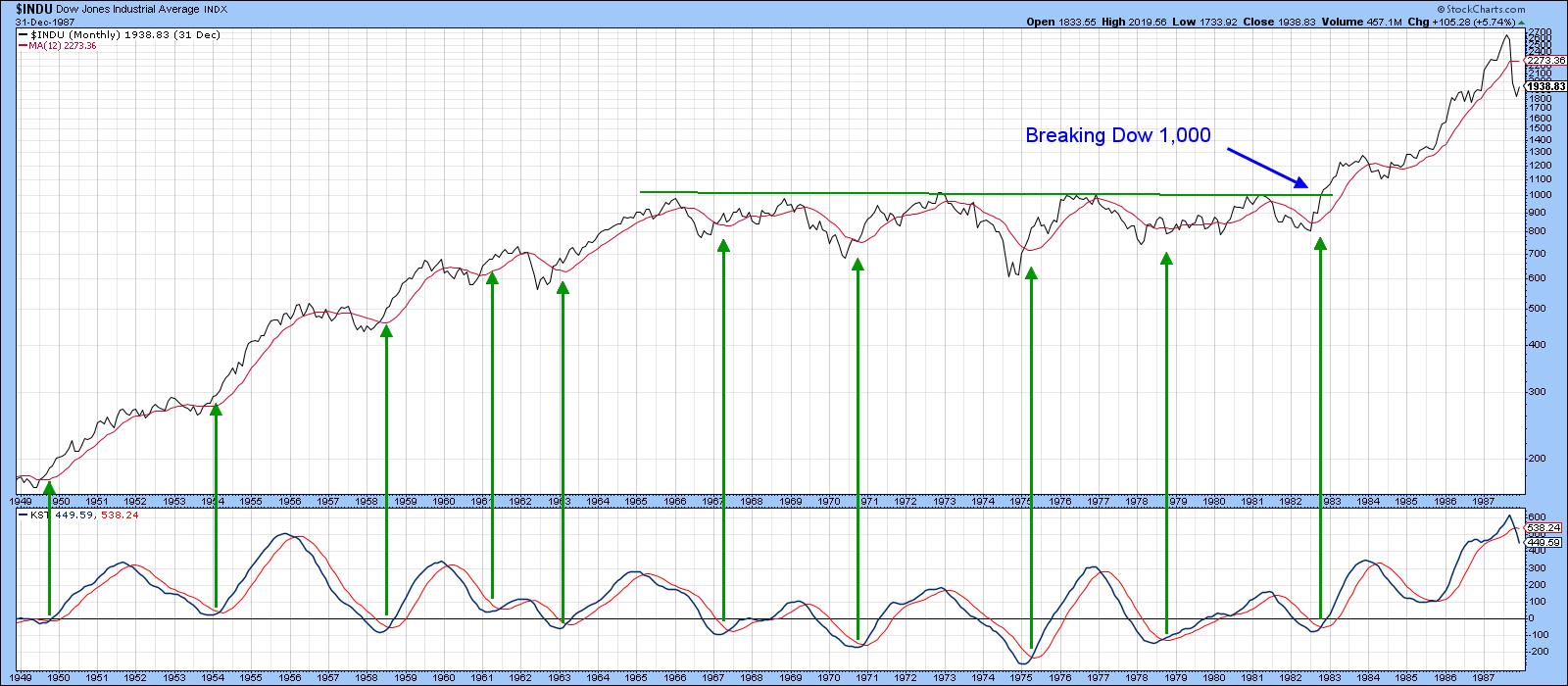 Chart 1 Chart 1
Chart 2 tells us that no such base is currently forming, the last decade having experienced an almost linear type of advance. One thing we can say is that the long-term KST has just triggered its fifteenth low risk buy signal since 1949. All the others were followed by a bull market. Need I say more?
 Chart 2 Chart 2
It's only when we turn to the global equity scene that similar base-building characteristics to the 1966-1982 US experience are apparent. In effect, there are some global charts that suggest something big could be in store for 2021 and beyond.
Chart 3 features an inflation-adjusted Dow Jones World Stock Index, where it is possible to construct a trendline connecting the 2000, 2007, 2018, 2019 and early 2020 peaks. That's not as clear a level of resistance as we had for Dow 1,000. Nonetheless, it still represents an obvious dynamic barrier of resistance. That resistance was cleared at the end of November, triggering a newly-minted long-term KST signal. The momentum signal in and of itself would normally be expected to have a positive effect for a year or two. However, the upward penetration of the trendline is closer to the significance of the Dow breaking 1,000. In other words, the KST will help validate the upside breakout, but the penetration of the line is what signals the likelihood of a forthcoming multi-year advance.
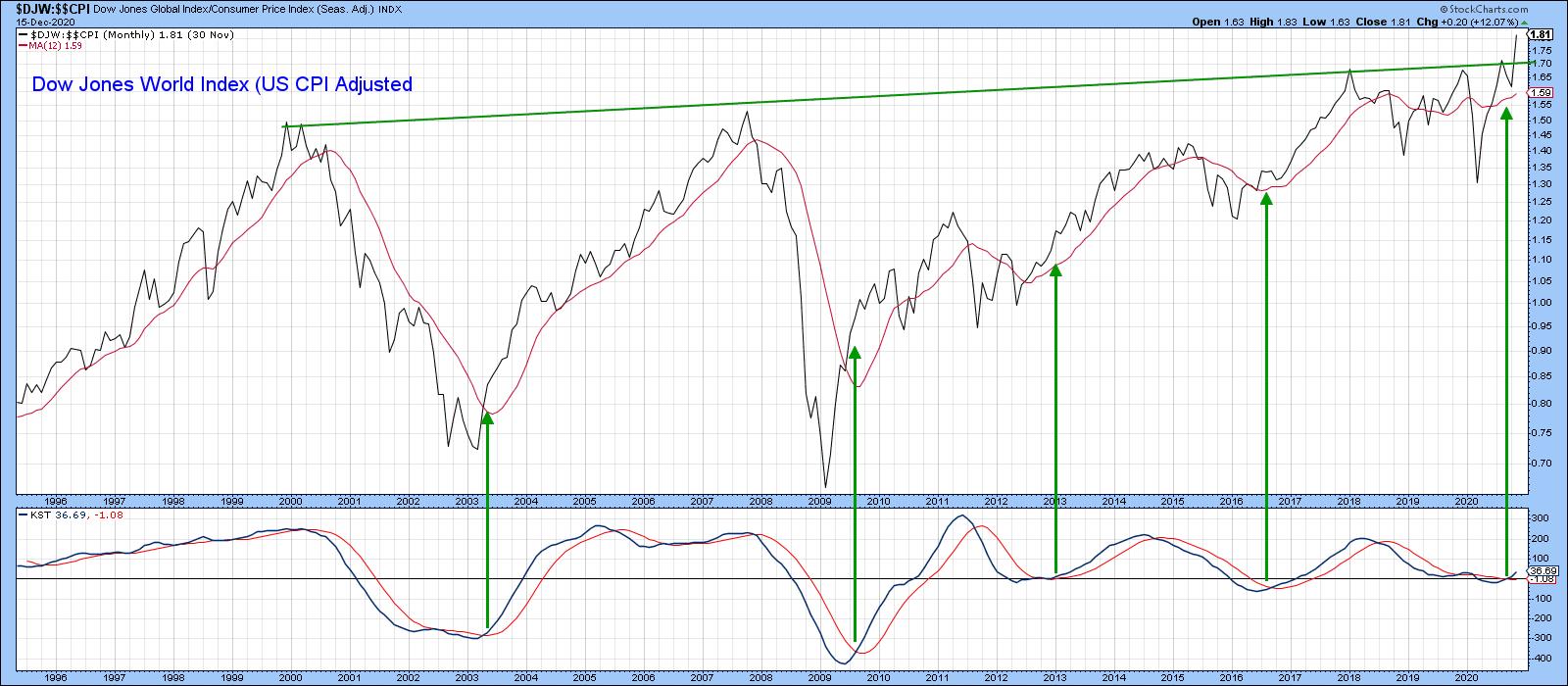 Chart 3 Chart 3
Europe
European stocks have been dragging since the year 2007, when the Dow Jones Europe Index peaked. Since then, it has been caught in a large trading range and is now in the process of challenging its previous highs. There are several reasons for expecting it to go through. First, the long-term KST has just gone positive. Second, the World Index has already broken to the upside.
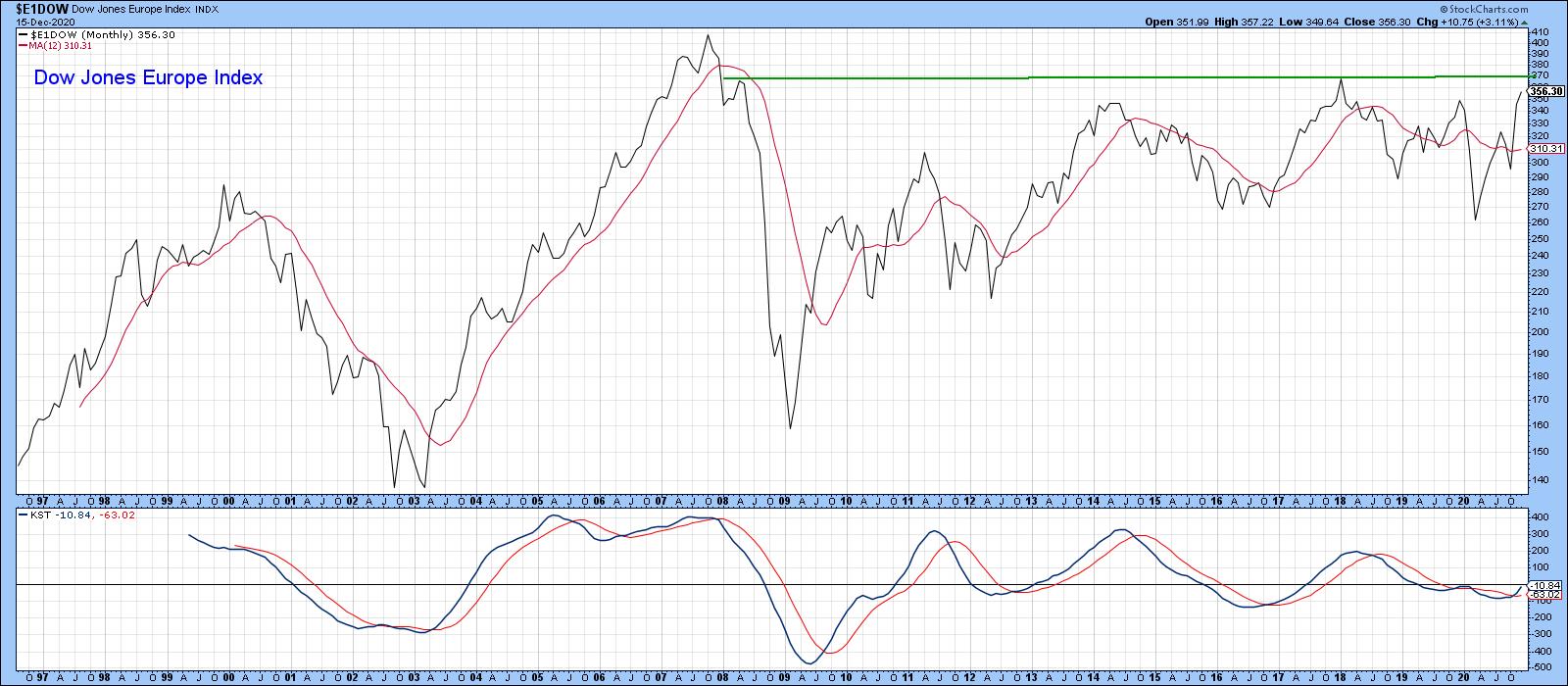 Chart 4 Chart 4
Finally, Chart 5 shows that the Nordic part of Europe is already leading the way higher.
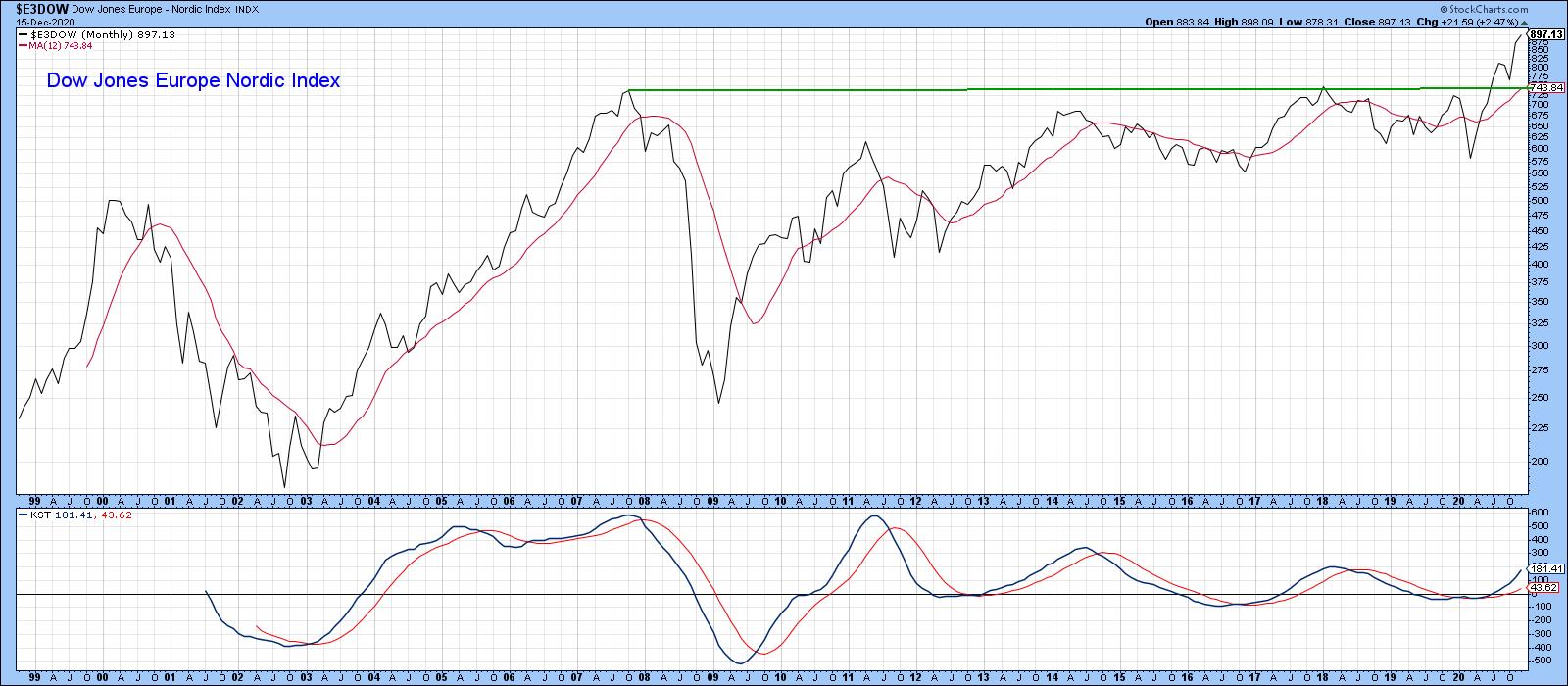 Chart 5 Chart 5
Two countries that are right on the brink of an upside resolution of a giant trading range are Germany (Chart 6) and Italy (Chart 7).
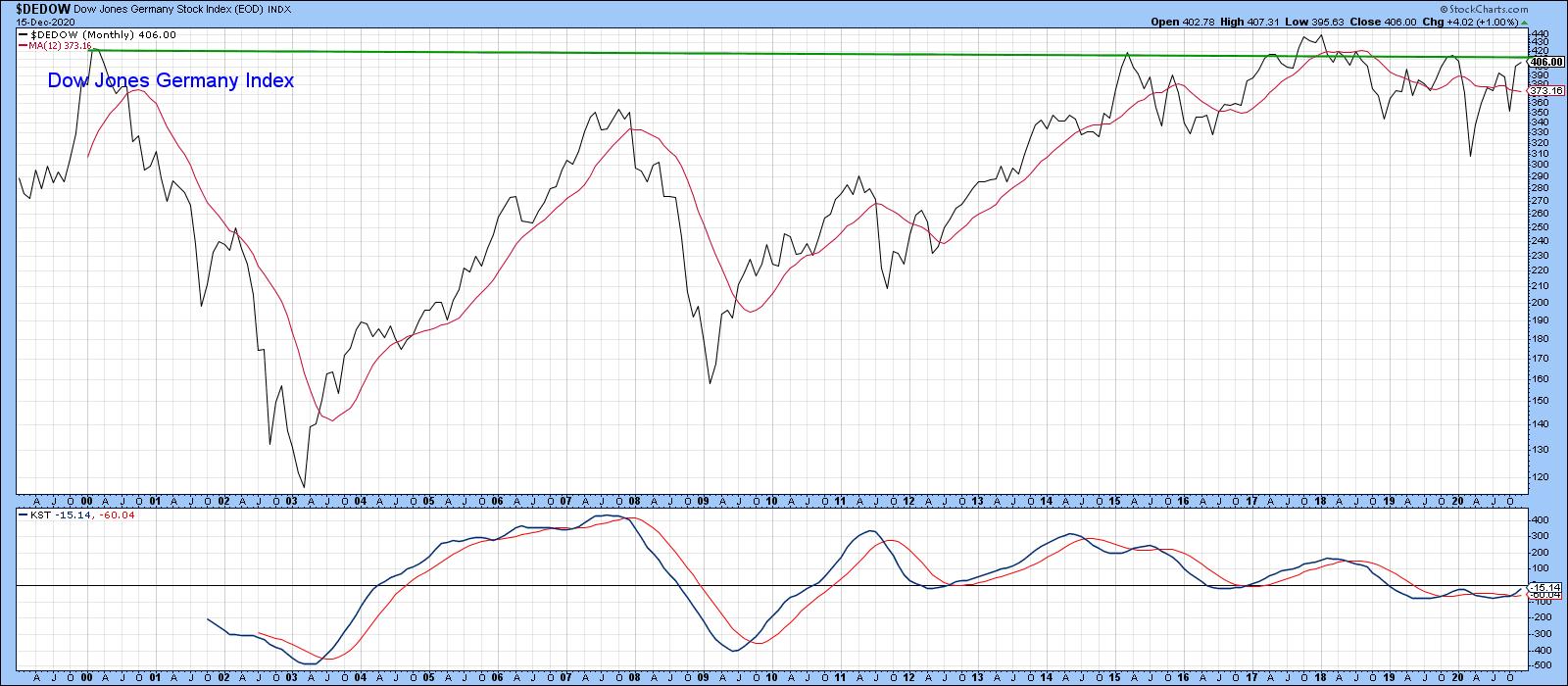 Chart 6 Chart 6
The Italian market has definitely lagged most of Europe in the last couple of decades. Now, however, it looks set to experience a breakout of its own - not necessarily to new all-time highs, but still with a good chance of achieving a multi-year advance of its own.
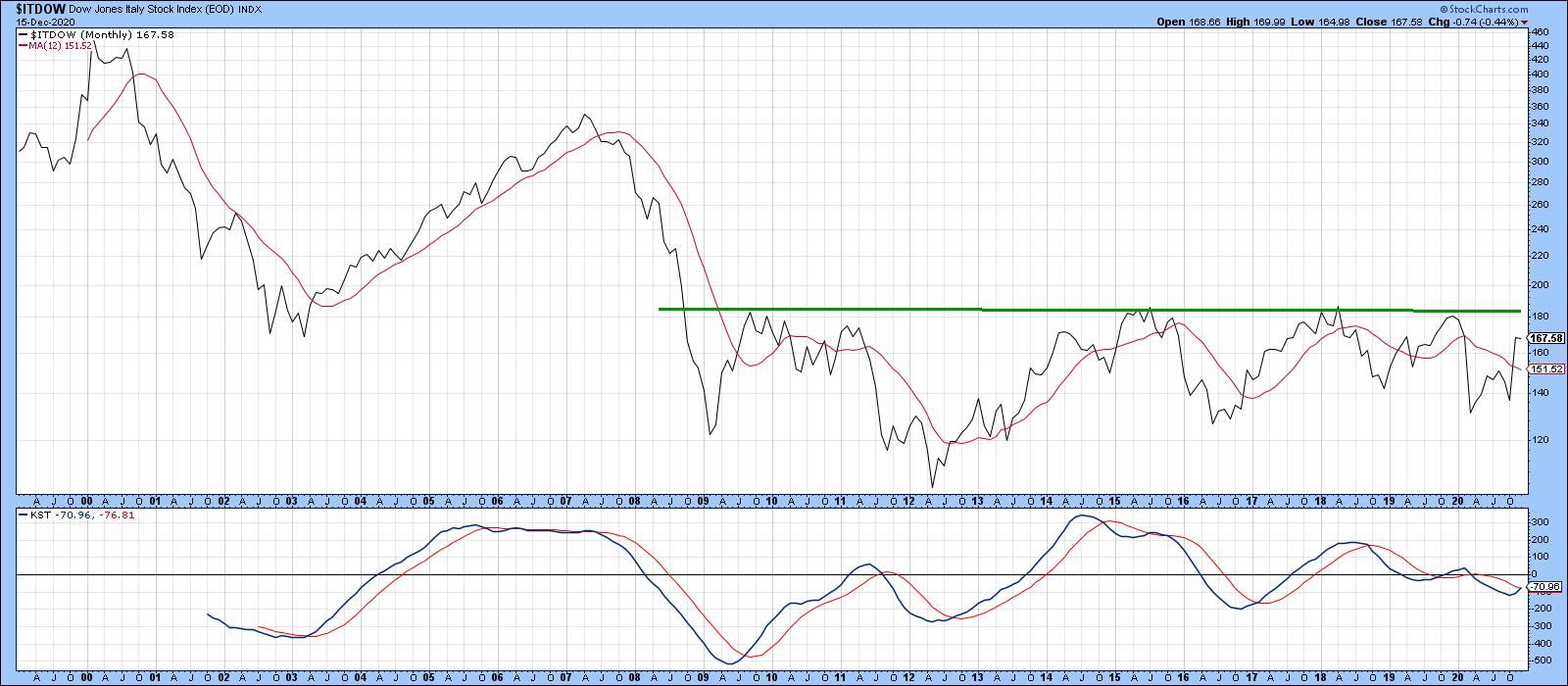 Chart 7 Chart 7
Asia
The Nikkei peaked way back in 1990 and since been confined to a giant trading range. Chart 8 shows that it has been zig-zagging its way higher since the 2008 low. That action represented the right-hand part of a 30-year trading range. November saw the Index literally explode out of this base, accompanied with a long-term KST buy signal.
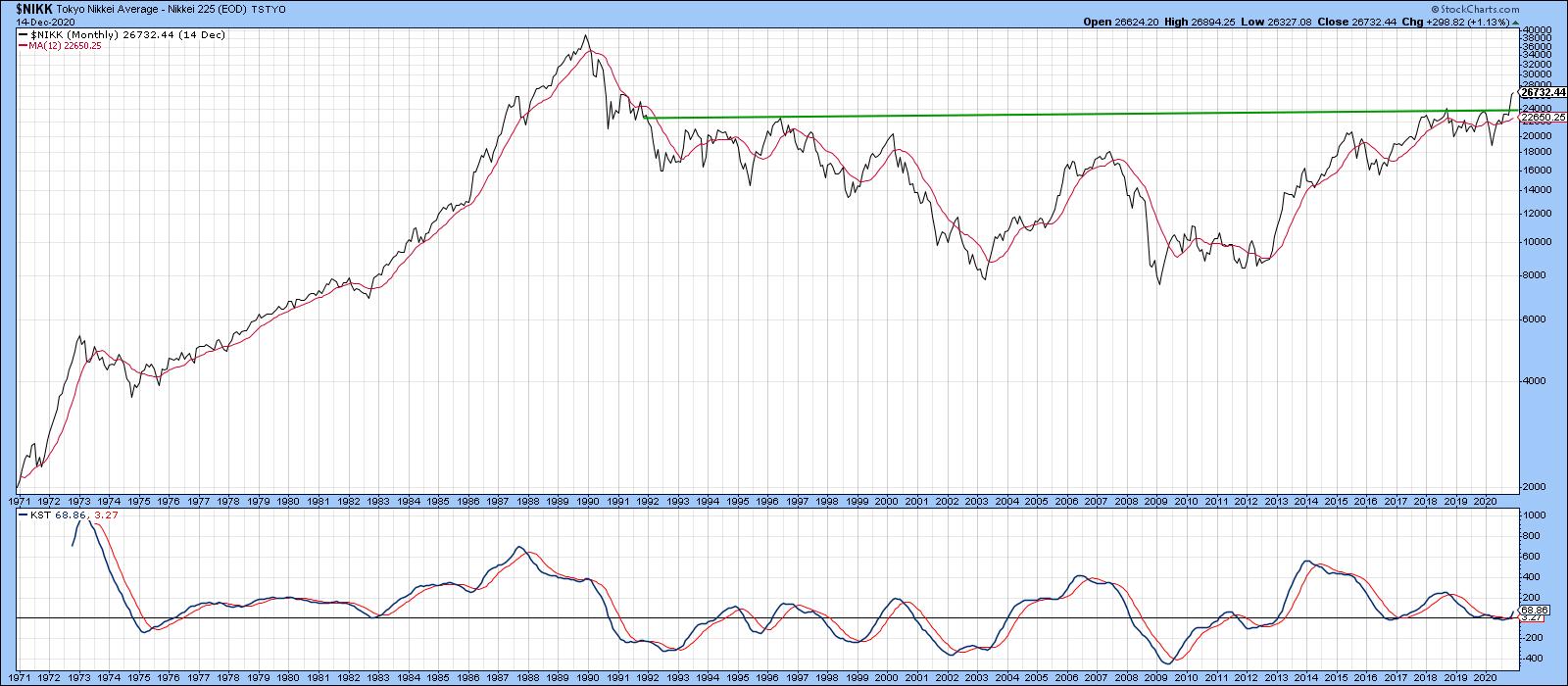 Chart 8 Chart 8
The Taiwan Weighted Index ($TWI) offers a great example of a former resistance level, in the form of the green trendline in Chart 9 reversing its role to support following the breakout. The index is clearly overextended near-term, but the size and depth of the 1996-2017 consolidation suggests that plenty of unrealized upside potential continues to exist.
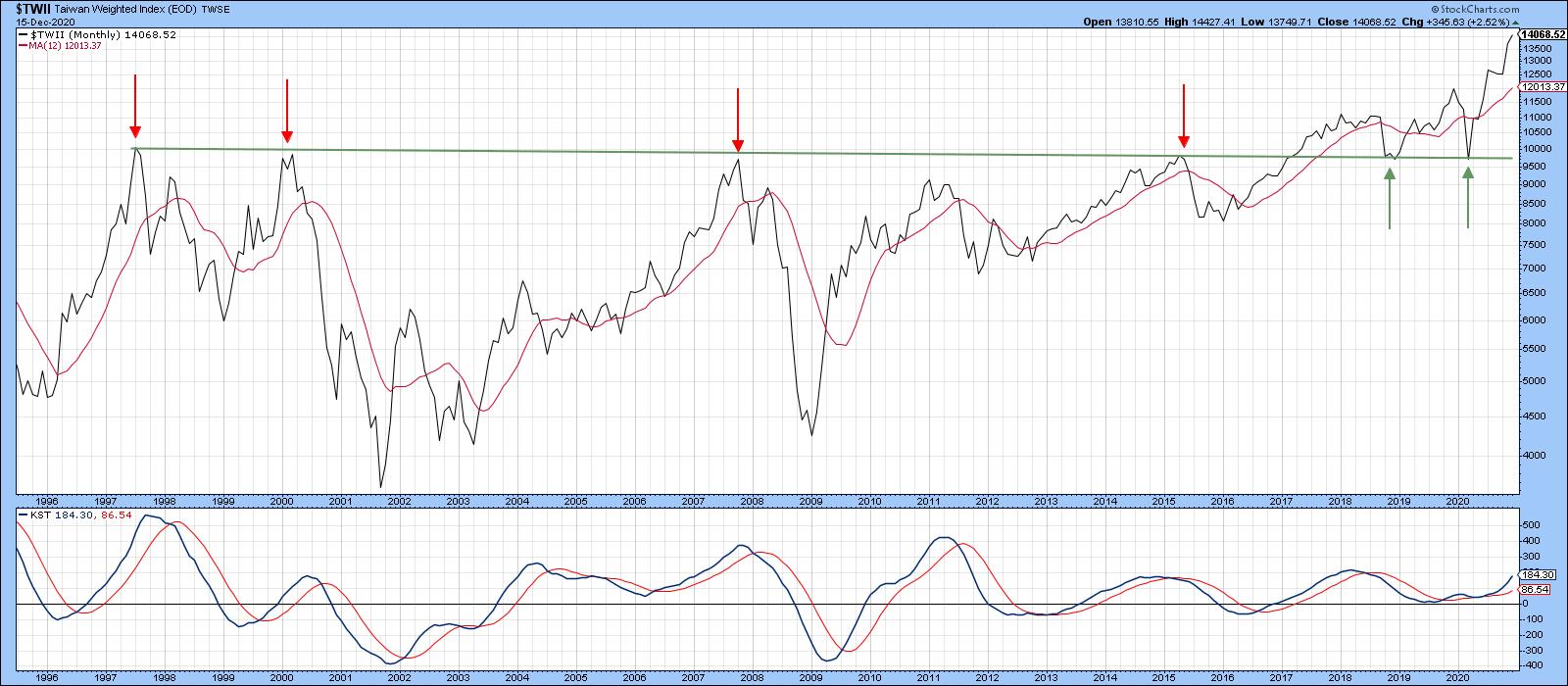 Chart 9 Chart 9
Emerging Markets
Chart 10 shows that the MSCI Emerging Market ETF is knocking on the door of a giant breakout of its own. Once again, a rising long-term KST strongly suggests that such a move will take place, thereby signaling the likelihood of a multi-year advance.
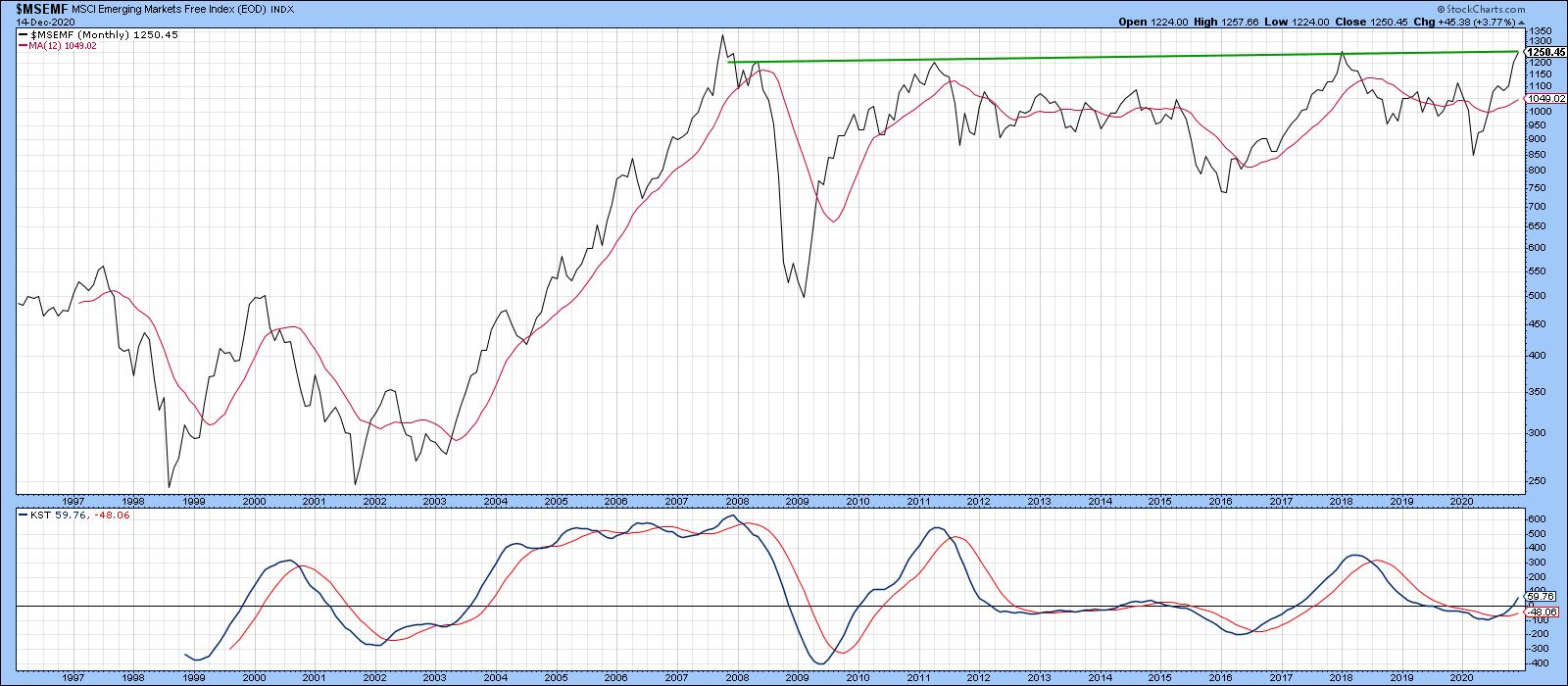 Chart 10 Chart 10
Back to the US
The US stock has not experienced a large trading range similar to some European and Asian markets. However, its price action relative to the 30-year bond has. That breakout developed in 2017. In early 2020, a normal retracement move took the ratio back to its extended breakout trendline. Now it has completed a right-angled broadening formation, as flagged by the dashed green trendlines. It has also experienced a long-term KST buy signal. Right-angled broadening formations are usually followed by above-average price moves. That's because they are, in reality, reverse head-and-shoulders patterns that are so positive they do not have enough time to form a right shoulder.
The breakout and KST buy signal only tells us that stocks are likely to outperform bonds, not that they will rally in their own right. However, the arrows plotted against the S&P tell us that KST buy signals for the ratio are typically followed by an extended advance in the Index itself. I have labeled the breakout "tentative" as this is a monthly chart; the latest plot can only take place officially at month's end.
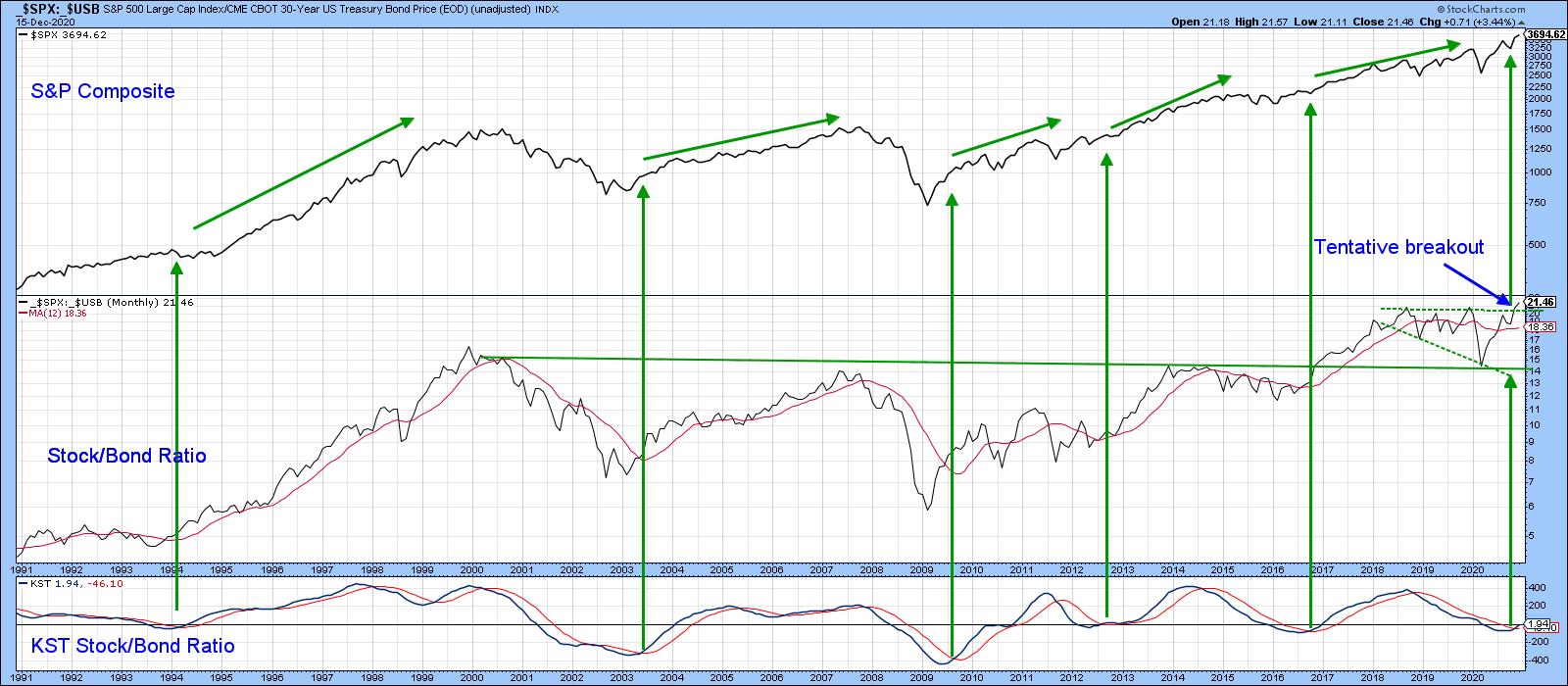 Chart 11 Chart 11
Currently, the market is very overextended on a short-term basis, so we should not be surprised if a near-term correction sets in. However, it seems to me that the positive long-term picture is so powerful that we are better served to focus on that, rather than a short-term correction that may or may not take place.
This article was originally published on Tuesday, December 15th at 6:19pm ET in the member-exclusive Martin Pring's Market Roundup blog.
Good luck and good charting,
Martin J. Pring
The views expressed in this article are those of the author and do not necessarily reflect the position or opinion of Pring Turner Capital Group of Walnut Creek or its affiliates.
|
| READ ONLINE → |
|
|
|
|
|
| The Mindful Investor |
| E-Commerce Names Charging Into 2021 |
| by David Keller |
As investors review the performance of stocks in 2020, e-commerce names like AMZN and SHOP exemplify the transition from brick-and-mortar stores to an online shopping experience. In the new year, potential stimulus packages and a rollout of the coronavirus vaccine should allow consumers to go back to old habits of purchasing goods and services in person.
Where will that leave high-flying e-commerce stocks? Our analysis suggests that the move to online shopping is not a temporary one, but more reflects a long-term transition into a more robust online economy.
2020 has been a solid year for e-commerce names by any measure. Here, we can see the year-to-date performance of the S&P 500 ETF (SPY), which is up around 17%. Out of the top four e-commerce ETFs, the best performer was the Amplify Online Retail ETF (IBUY), which was up around 125% over the same time period.
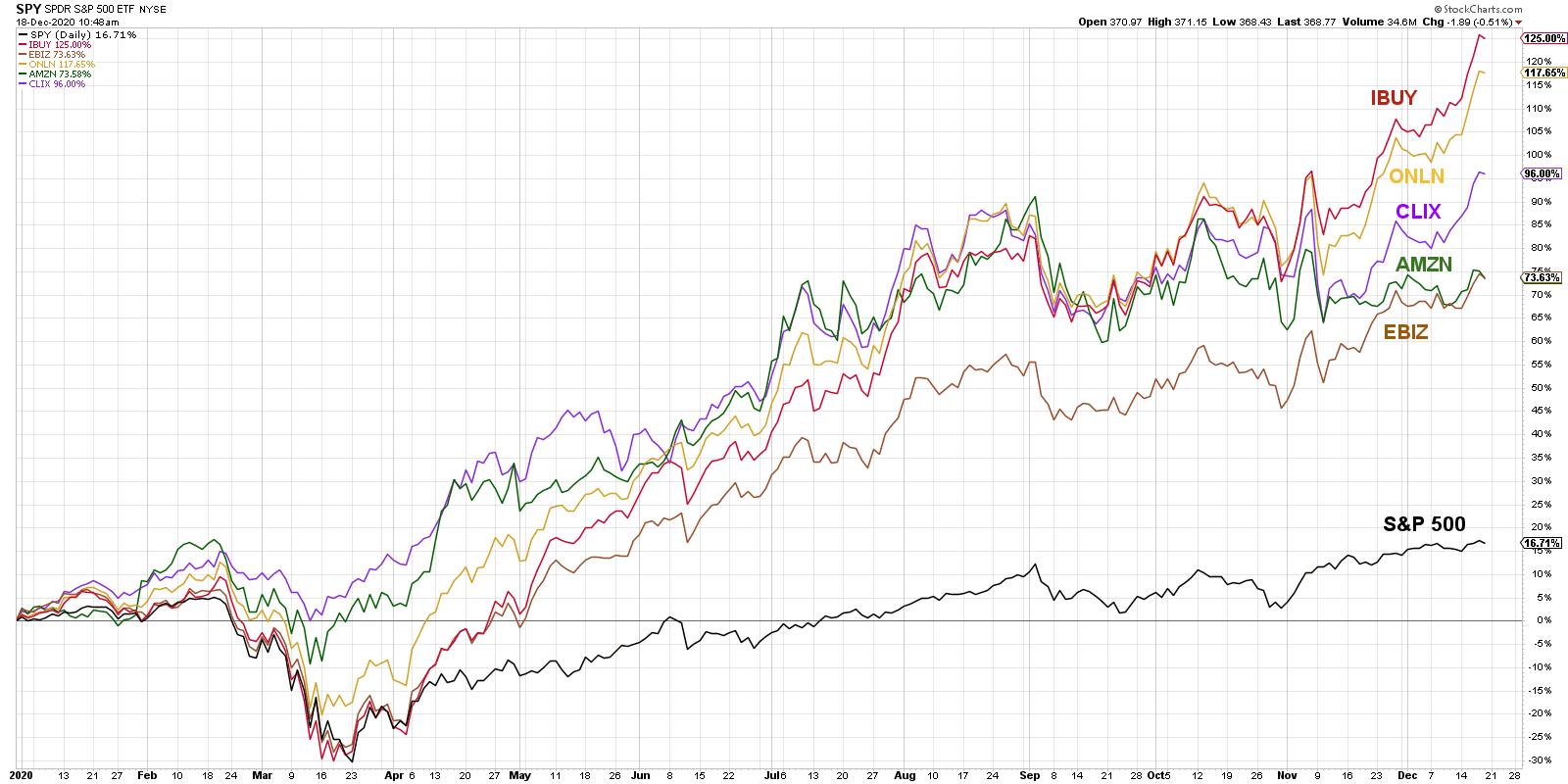
The ProShares Online Retail ETF (ONLN) gained 117%, the ProShares Long Online/Short Stores ETF (CLIX) was up 96% and the Global X E-commerce ETF gained 74% so far this year. The largest company by market cap in most of these ETFs is Amazon (AMZN), which, at +75% year-to-date, has outperformed the S&P 500 index by 58%!
While the year-to-date gains are certainly impressive, what really interests me is the performance of these ETFs before the March 23, 2020 market low. All four of the ETFs, as well as Amazon, outperformed the S&P 500 leading into the February market peak, as well as into the March low.
What this suggests is that, while the performance of these stocks has certainly been impressive as consumers have changed behavior during the course of 2020, it truly reflects a longer-term transition that has been happening for years.
In fact, when we rank the equity universe using our proprietary trend-following model called StockCharts Technical Ranking (SCTR), some of the largest holdings of these ETFs are in the top 1% of trends going into year end. ETSY Inc. (ETSY) has a ranking of 98.9 out of 100 and has been in a consistent uptrend of higher highs and higher lows since early April. Even with the emergence of Energy, Financials and other cyclical sectors in the fourth quarter, ETSY is still making new 52-week highs in December.
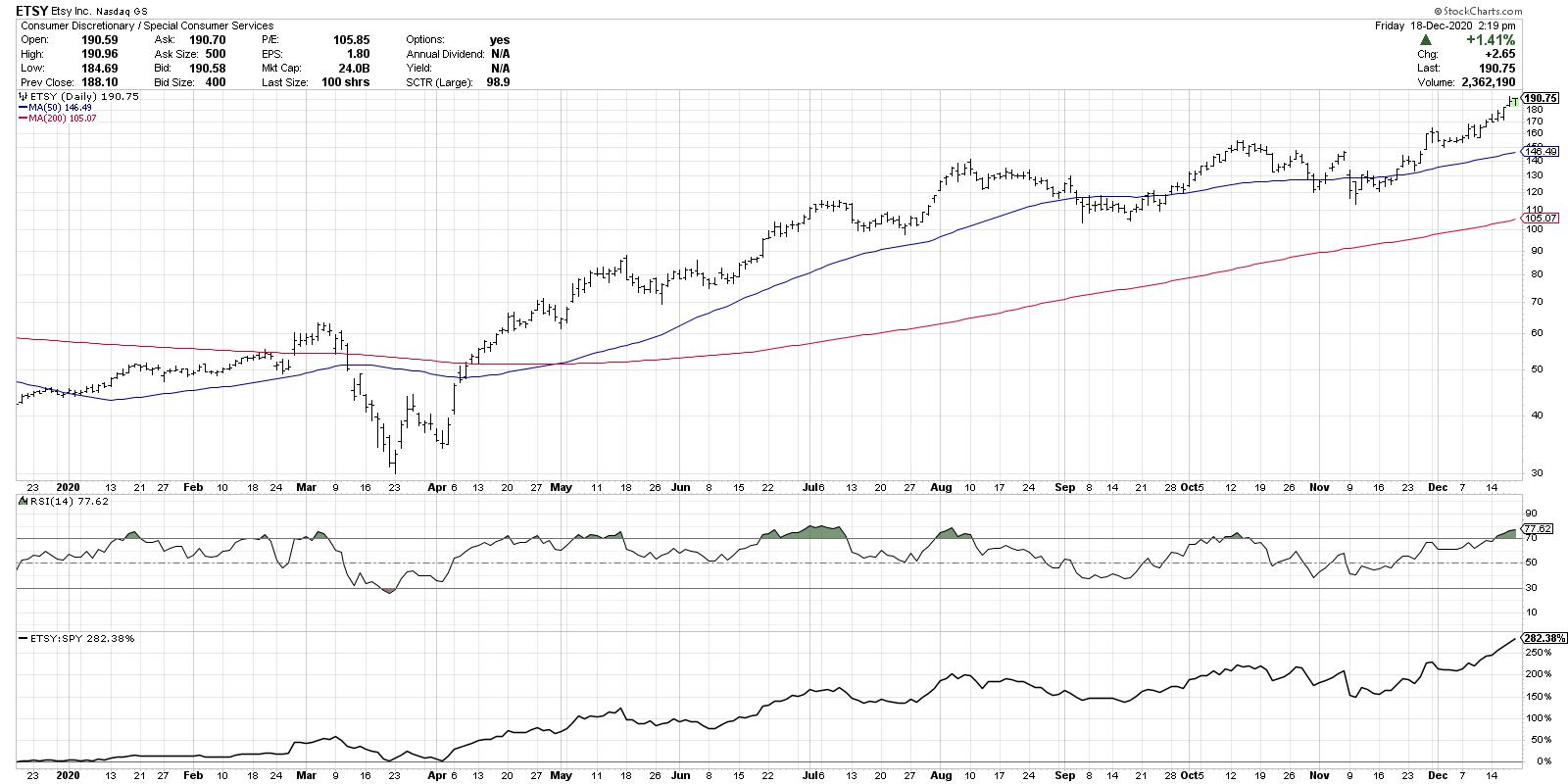
Chewy Inc. (CHWY), which provides a purely online pet shopping experience, has exploded to new highs in recent weeks and now is approaching the important $100 level. Stocks often find resistance at "big round numbers" as investors tend to use that price as an opportune moment to reflect on the true value of a stock.
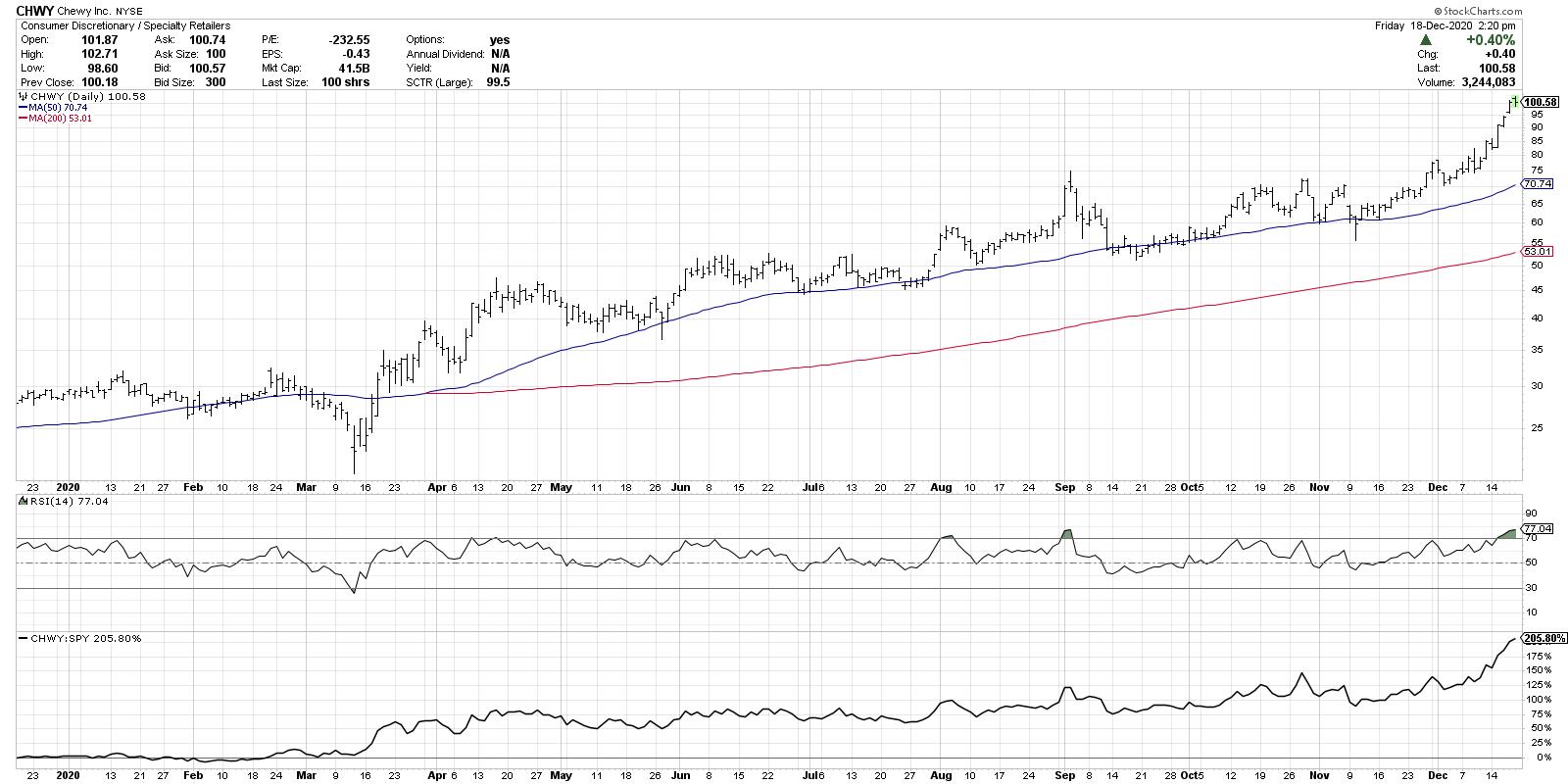
The current largest holding in the Amplify Online Retail ETF is Stitch Fix, Inc. (SFIX), which is ranked 99.7 out of 100 in our mid-cap SCTR universe. This stock had leveled off around $40 until a positive earnings report in early December caused traders to flood into the name and propel the stock into the low 70's.
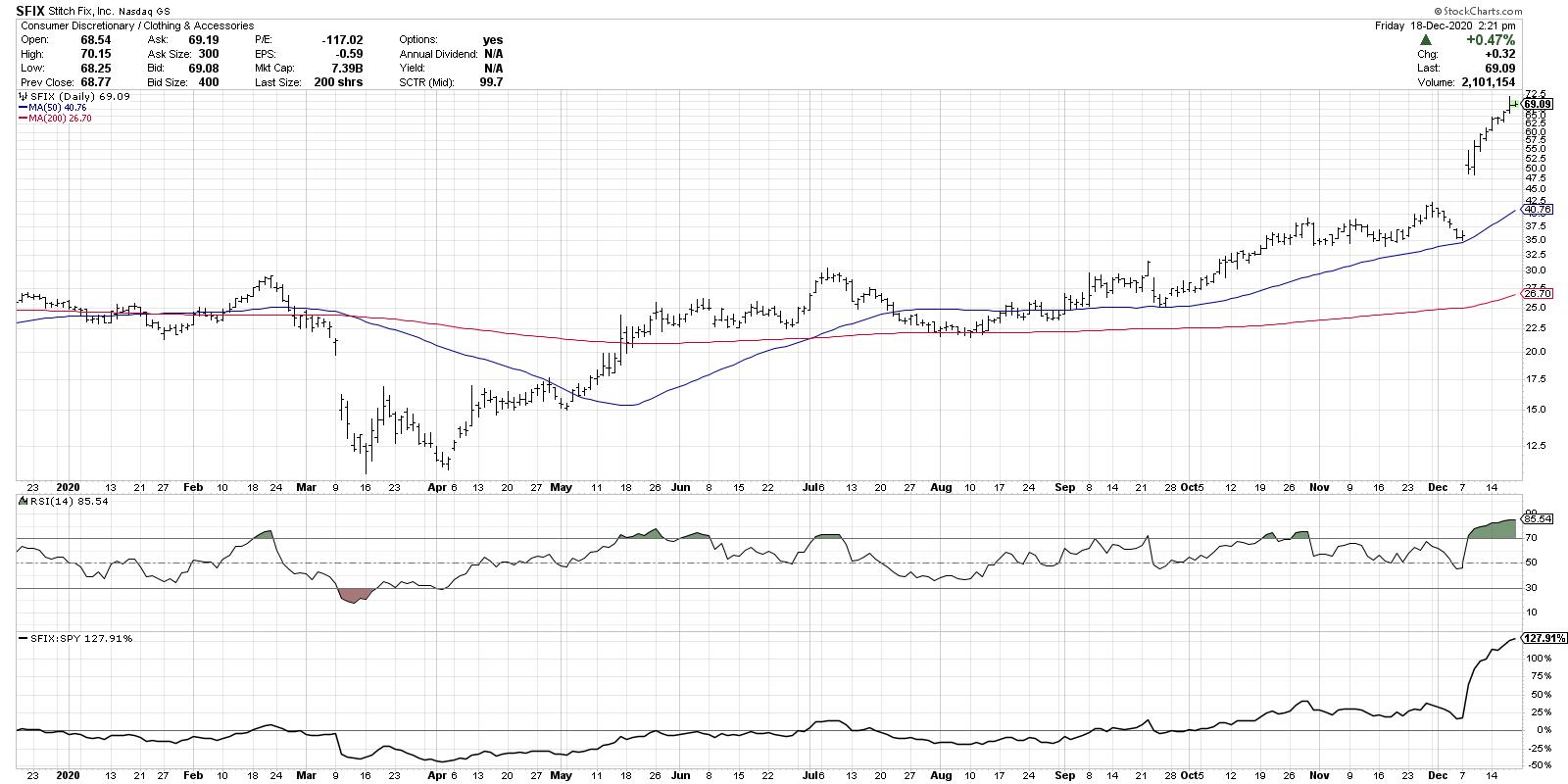
What about the largest company in the space, Amazon.com (AMZN)?
As with many of the FAANG stocks, Amazon has moved into consolidation mode in the recent months after driving the market into the summer months. Now we see a pattern of lower highs and higher lows as AMZN settles into a range around the $3200 level.
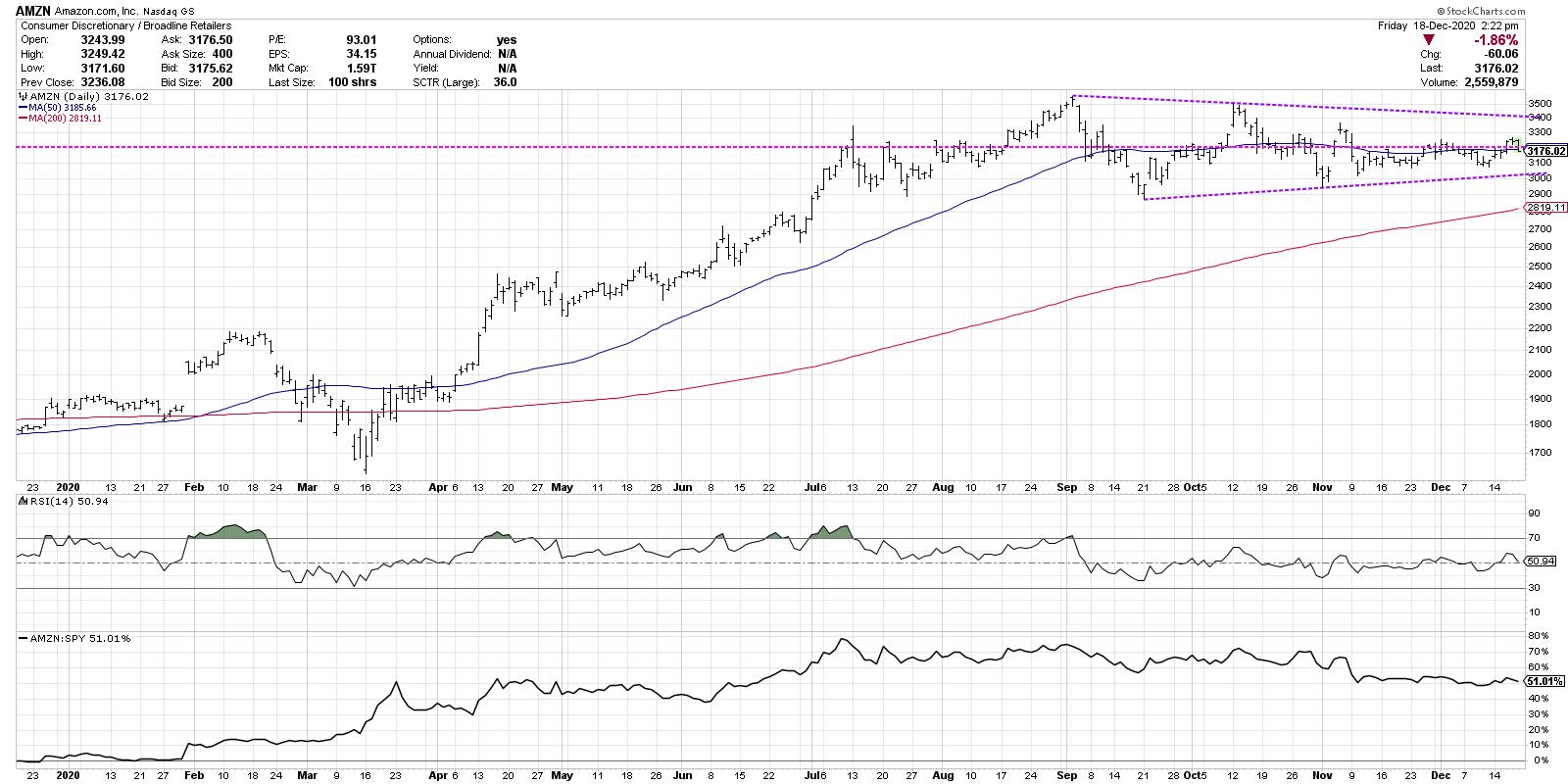
While other stocks in the space have been breaking higher, which is certainly an encouraging sign for the e-commerce theme, a breakout on the Amazon chart would convince many investors that there is opportunity for much further upside for the space.
A breakout above the September high around $3500 would provide a signal to many investors that there is much greater upside potential for AMZN and the rest of the e-commerce stocks.
So what's the risk to the "strong e-commerce in 2021" thesis? Quite simply, the risk is that, when given the opportunity to go back to previous purchasing patterns, consumers stop scratching the online shopping itch and return en masse to brick-and-mortar stores.
Shopify (SHOP) and PayPal (PYPL) may be good names to watch to determine the likelihood of that sort of mean reversion taking place. While other stocks in these e-commerce ETFs are pure plays on online stores vs. traditional retailers, a company like Shopify is trying to help small- and medium-sized businesses process online transactions.

Both SHOP and PYPL have made new 52-week highs in December, breaking out above previous resistance levels established in early September. Continued strength in these names would show that traditional businesses are continuing to rotate to more online transactions and see that as a key part of their strategic plan in 2021 and beyond.
RR#6,
Dave
David Keller, CMT
Chief Market Strategist
StockCharts.com
Disclaimer: This blog is for educational purposes only and should not be construed as financial advice. The ideas and strategies should never be used without first assessing your own personal and financial situation, or without consulting a financial professional.
The author does own a position in SHOP at the time of publication. Any opinions expressed herein are solely those of the author, and do not in any way represent the views or opinions of any other person or entity.
|
| READ ONLINE → |
|
|
|
|
|
| Trading Places |
| Here's Why I'd Be Buying an Overbought Market |
| by Tom Bowley |
Since the March lows, the NASDAQ has seen its RSI approach or pierce the overbought 70 level on 11 different occasions. The only meaningful correction that's taken place on any of those 11 occurrences, though, has been the September selling. Historically, September is a poor month, so we shouldn't be too surprised by a 12-13% correction. It didn't help that the NASDAQ rose 9.6% in August! In one month! Then it tacked on more than 2% in the first two days of September. Yes, we were in dire need of some relief - and we got it.
Since clearing the triple top established at the September high (12,074.06), October high (11,965.54) and the November high (12,108.07) on November 25th, however, the NASDAQ has tacked on another 5.54% in just 4 weeks. I understand the trepidation here after a surge higher. A trip back to test the rising 20-day EMA can happen at any time. I wouldn't bank on it happening, but if it did, I wouldn't be spooked. The following is a NASDAQ chart and I'll discuss a couple reasons why I believe this rally hasn't ended:
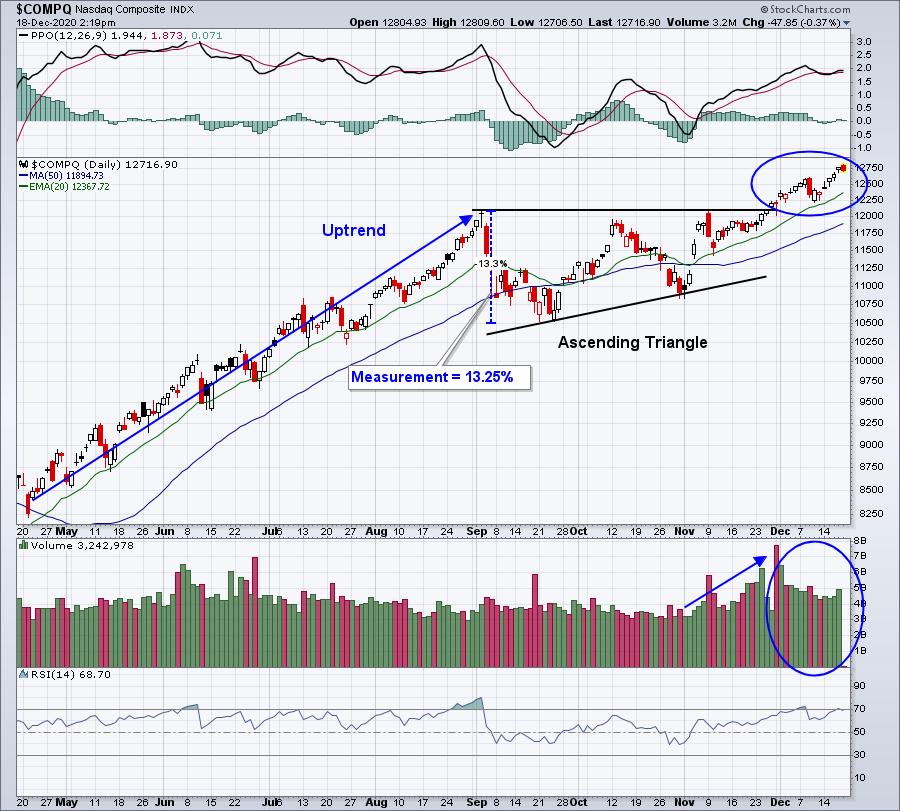
Reasons to remain bullish:
(1) We broke out of a very bullish ascending triangle continuation pattern that measures another 13.25% higher (initially) after confirming its breakout on strong volume. That measurement is roughly 13,700, another 1000 points higher than the current level.
(2) That volume reeks of accumulation. We're not just going higher; institutions are buying stocks by the fistful. If the volume doesn't impress you, then maybe the AD line will:
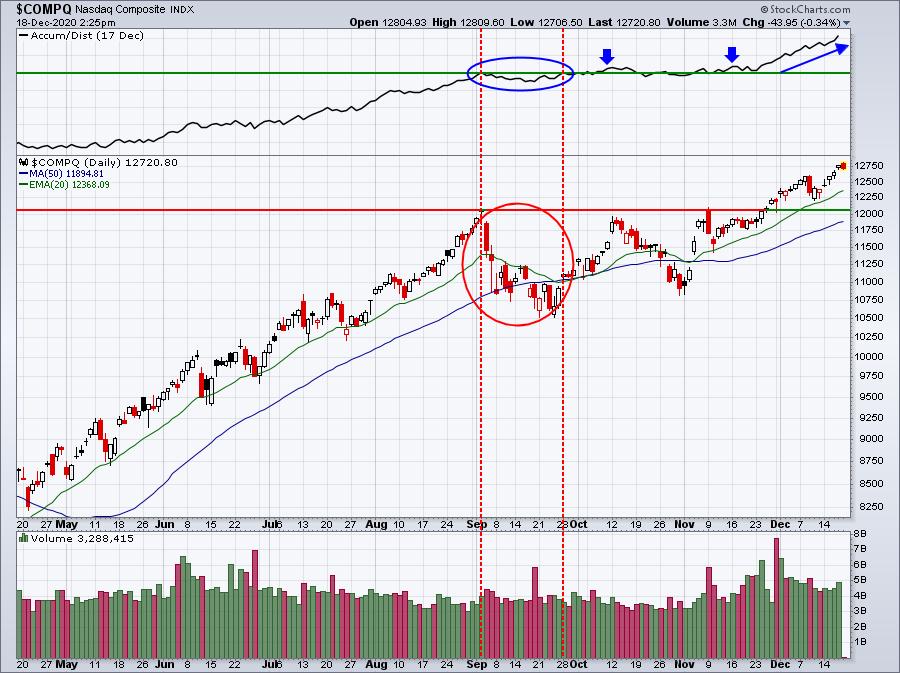
A couple more points to be made here about the obvious accumulation taking place:
(1) Look at the September "selling." Prices moved lower for sure, but the AD line held up beautifully. This is EXACTLY what we saw in March. While everyone was selling, institutions were buying every share they could get their hands on in certain sectors and industry groups. The same holds true now.
(2) Now look at that AD line as prices move higher. Do you see any "funny stuff" going on here? I sure don't. I believe stocks are being bought in droves heading into 2021.
Again, we might see a bit of profit-taking and rotation that carries us down to test our rising 20-day EMA, but I just don't see anything more than that. But that brings me to my final point.
Rotation.
This is a hallmark of secular bull market advances. Yes, some groups and some stocks will take a short-term beating because money rotates out of that group and into other groups. We saw software struggle for a few months, but now that group is rallying again. Over the past month, the hottest sector has been energy (XLE). Need proof? Here's a one-month snapshot of sector performance:
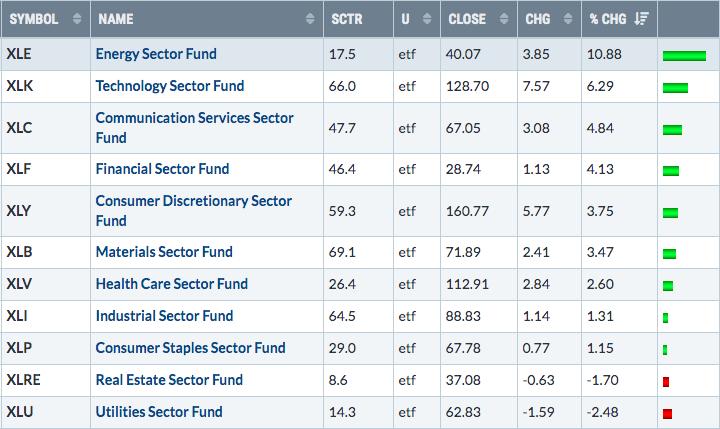
Energy has had a HUGE month by any measure. But rotation has taken its legs out from under it. Look at the last week's sector performance:
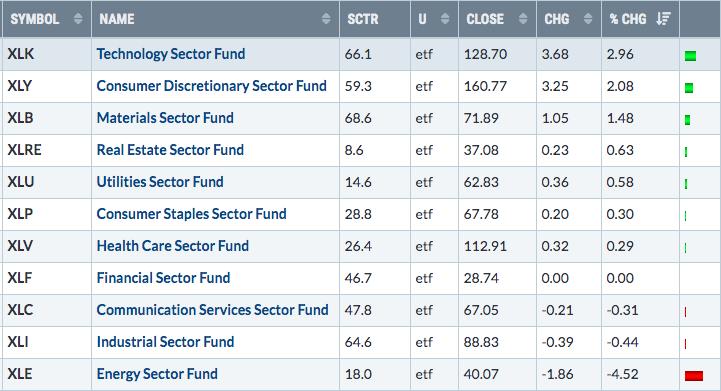
Profit-taking can surely be blamed for this. But also don't overlook monthly options expiration. After that big month, energy entered this week with TONS of net in-the-money call premium. The money was there for the taking by market makers, and I discussed this with EarningsBeats.com members on Tuesday night at our December Max Pain webinar. While the market has rallied, energy has not.
Getting back to my earlier overbought discussion, I continually update a Strong Earnings ChartList with companies that beat Wall Street estimates as to both revenue and EPS, are liquid (trade at least 200,000 shares per day) and look solid technically. I just updated this ChartList this afternoon and there are currently 491 charts on this list. While the NASDAQ and S&P 500 might be showing short-term overbought conditions, many stocks on this list are not. This gets back to rotation. There's no need to chase the overbought stocks, because there are plenty of others that have already seen profit-taking and are poised to move higher - and without all the risk that chasing entails. I ran scans to break down these 491 Strong Earnings ChartList stocks by RSI level. Check out the distribution of RSI levels:
- Number of stocks with RSIs over 90: 1
- Number of stocks with RSIs from 80-90: 21
- Number of stocks with RSIs from 70-80: 94
- Number of stocks with RSIs from 60-70: 164
- Number of stocks with RSIs from 50-60: 141
- Number of stocks with RSIs from 40-50: 65
- Number of stocks with RSIs below 40: 5
That's a fairly solid distribution among various levels of overbought and oversold. More than 40% of our Strong Earnings ChartList stocks have an RSI reading below 60. Clearly, there are plenty of stocks that are not overbought, so don't avoid stocks because of a general belief that they've run too far. There are opportunities everywhere!
This is my final ChartWatchers newsletter article of the year. As 2020 draws to a close, I want to thank everyone in our StockCharts.com and EarningsBeats.com communities. We're rewarding our EarningsBeats.com members with our best annual deal of the year - sign up for 12 months and we'll throw in 2 free months. Annual members also can attend our MarketVision 2021 event tomorrow at no additional charge ($197 value). That special can be found HERE.
I also want to thank our FREE EB Digest community and everyone at StockCharts.com. On Monday, December 21st, in our EB Digest newsletter, I'll feature a trading candidate from this Strong Earnings ChartList that's not overbought at all. I'll also provide a FREE link to our Strong Earnings ChartList - all 491 stocks ANNOTATED with key price support levels to watch. You'll be able to download this ChartList directly into your StockCharts.com account, if you're a StockCharts.com Extra or Pro member. You must SIGN UP for our EB Digest newsletter prior to Monday morning to gain access to this ChartList, however. CLICK HERE to join our EB Digest newsletter. There is no credit card required and you may unsubscribe at any time.
Happy trading!
Tom
|
| READ ONLINE → |
|
|
|
| RRG Charts |
| Getting Your Options Right Around Communication Services |
| by Julius de Kempenaer |

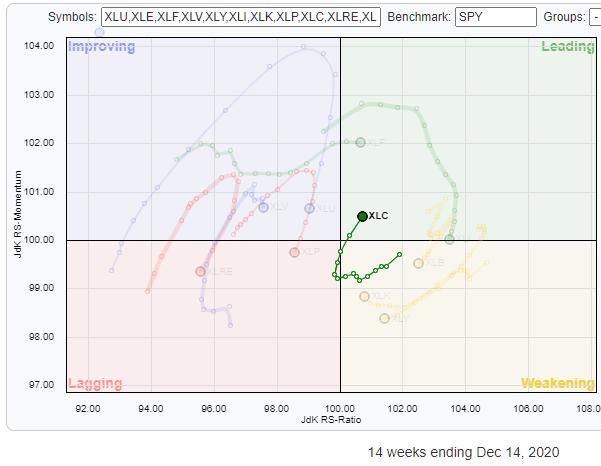
Over the last weeks, the Communication Services sector continued to improve and recently moved back into the leading quadrant after rotating through weakening and, very briefly, through lagging. This rotation, especially the increase in RRG-Velocity (the distances between the week-to-week observations), make XLC an interesting sector to keep your eyes on.
The small RRG on the right shows that rotation over the last 14 weeks. Click on the image to blow it up and get the link to the live chart.
Of course, you could just get a position in XLC and get broad exposure to the sector as a whole, but for some people that may not be enough.
Zoom in on Individual Communication Services Stocks
To get a more detailed view of what is going on inside the Communication Services sector, we can open up the Relative Rotation Graph showing the rotations for all individual stocks in the sector against XLC as the benchmark.

Going over the positions and the directions (RRG-Heading) of these tails shows there are a few stocks that are in the top-ten of holdings for XLC that are inside the lagging quadrant or rapidly heading in that direction.
The information on holdings for these ETFs is publicly available on the State Street website.
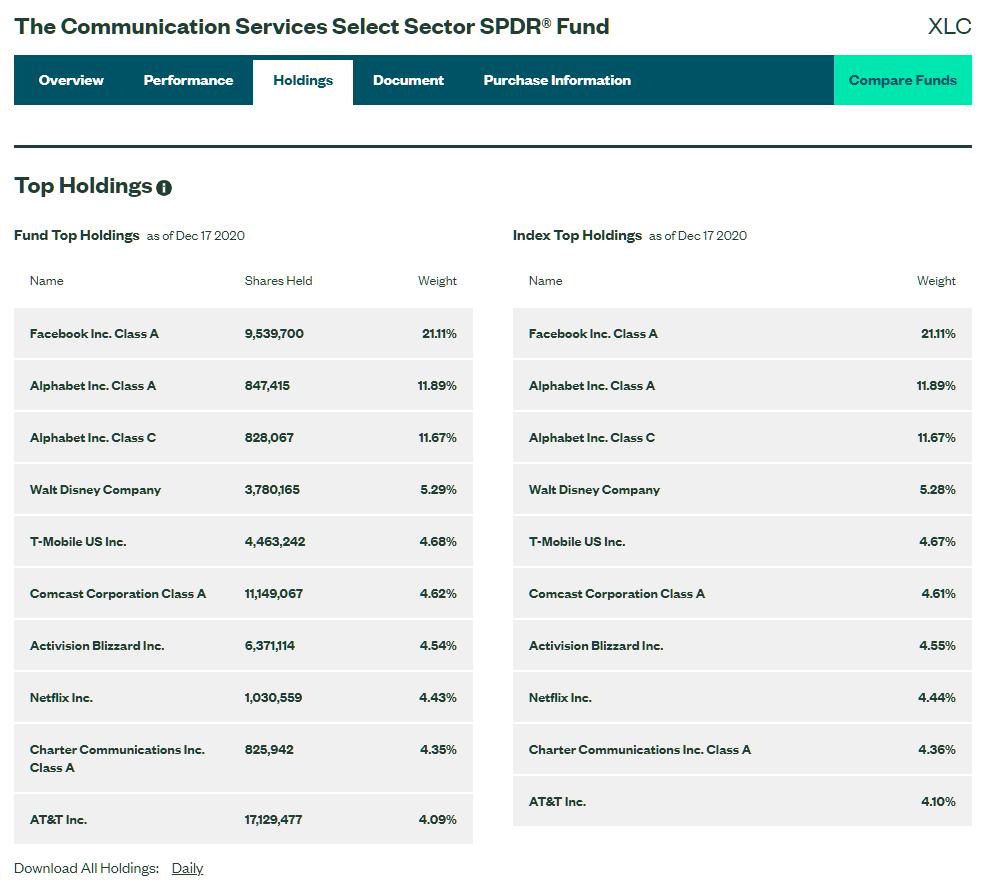
The RRG below zooms in on the tails for these top-ten names inside Communication Services.
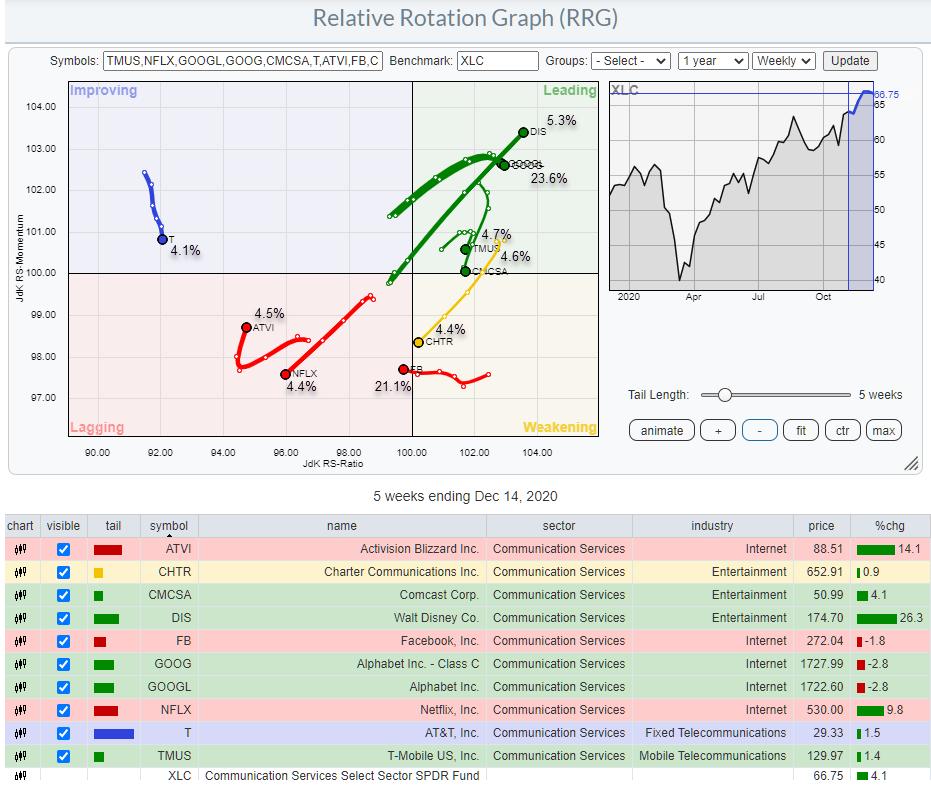
Roughly adding up the percentages, we have about 38% inside the leading quadrant + 4.5% of ATVI just turning around to a 0-90 degree heading while breaking to new highs. And then there is 34% inside lagging or close to crossing over (T, and CHTR).
We Like XLC But Not FB
Now, since StockCharts.com recently partnered with Tradier Brokerage to offer flat fee options trading (and commission free equities trading), it makes sense to bring in some ideas to use options to fine tune portfolios and/or positions. In this particular case, it could be interesting to (partly) get rid of the exposure to Communication Services stocks that are negatively affecting the performance for the sector. The most important one here obviously being FB, and to a lesser degree CHTR, NFLX, and T.
Options offer us the possibility to fine tune allocations. The base assumption is that we want to have positive, long, exposure to the Communication Services sector by buying the XLC ETF. But we are not happy with the exposure to FB.
When you own an ETF like XLC, you can calculate your exposure to each individual stock in that ETF. FB makes up a little over 20% of that ETF. This means that, in every share of XLC, 20% is FB.
One way of "removing" the exposure to FB inside XLC could be to sell short an equivalent of 20% of your total XLC holding in FB. That would be a DELTA-1 solution. This completely hedges the exposure to FB within XLC.
With XLC at $66.75 and FB at $272.00, that means for every $1360 (20.4 shares) in XLC, you can sell 1 share of FB.
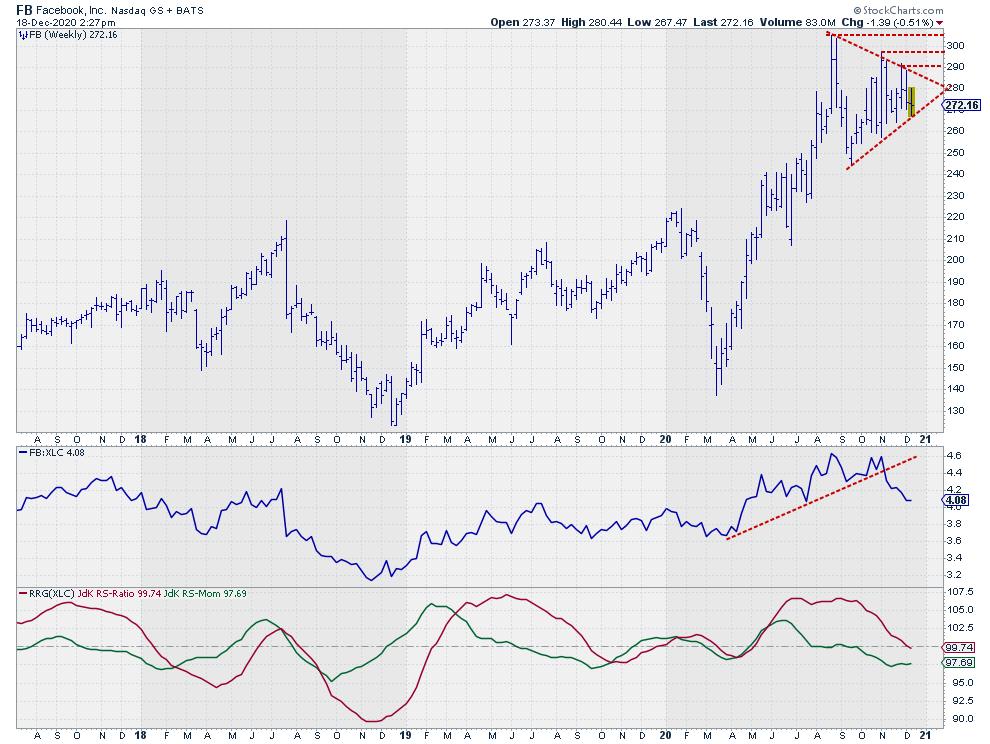
A look at the chart for FB shows that the price is currently caught inside a symmetrical triangle, while relative strength has clearly broken rising support and is now moving lower, pushing both RRG-Lines below 100 and the tail into the lagging quadrant on the RRG.
With this sort of weakness in relative strength vs. the sector, an upward break from the triangle will have a hard time rallying strongly while facing a few previous highs as resistance levels on the way.
Selling Calls To Remove Exposure
An options strategy to consider to (partly) remove exposure to FB could be to SELL CALL options with a STRIKE price (far) below current levels, i.e. a deep in-the-money call. So, in this case for example, a strike price of $250.
A FEB21 CALL 250 currently trades around $ 26.70, with the stock at $ 273.00. As 1 option represents 100 shares, you would need a position of roughly 2000 XLC ($136.000 equivalent) to sell 1 CALL option on FB. This would generate $26.70 (*100) in proceeds from the sale.
What this essentially means is that you are selling FB at $276.70 (strike + premium). When FB rises, the position will not benefit and will be the equivalent of XLC without FB, so you'd be lagging the performance of XLC.
When FB remains the same or goes down, the option position will start to "work". At this moment, the intrinsic value of that option is $273.00 - $250.00 = $23 and, thus, there is currently $3.70 of time value.
If FB does not move and our option expires on 1/15/21 with FB at $273, we need to close and buy back that option at $23 and we have gained $3.70.
If FB declines and at expiration trades at, say, $260, the position needs to be closed at a cost of $10, so profit will be the $3.70 + $13 = $16.70.
With a price for FB on expiration at or below $250, this call will expire worthless and generate max profit of $26.70.
As we also still hold the XLC ETF, the gains on the sold FB CALL option will partly off-set any potential decline in XLC or when XLC manages to rise into January, add to the profit of the combined position.
Of course when the option expires, the XLC position remains and you can start all over again.
As the price of FB is very high in $ terms, it requires quite a big position in the ETF to make such a strategy work and, therefore, may not be viable for smaller portfolios. Also, as XLC will not be accepted as collateral for "naked" calls, you will need to deposit margin to be able to sell these calls without protection.
What I wanted to do is show how options can help to create more tailored and granular exposure than a straightforward ETF position. Let me know what you think!!
My regular blog is the RRG Charts blog. If you would like to receive a notification when a new article is published there, simply "Subscribe" with your email address.
|
| READ ONLINE → |
|
|
|
| DecisionPoint |
| Is Solar Teflon? |
| by Erin Swenlin |
If you have attended the free DecisionPoint.com Trading Room or you are a DecisionPoint Diamonds Report subscriber, you'll know that I have been very bullish on renewable energy stocks since the beginning of autumn. While they can be very volatile, overall they are an industry group that is flourishing and, if you can take those ups and downs, it will continue to be a prosperous sector.
Originally, Renewable Energy had been listed as part of the Energy sector on StockCharts. Since then, it has been moved to the Technology sector, where it has found a home among other outperformers. Technology's one failing is that it is a "leading" sector -- meaning it generally picks the direction for the overall market. That works well most of the time, as it outperforms in bull markets; however, when the market gets toppy like it is right now, you're exposed to positions in a sector that will likely lead to the downside.
This is why I like solar. I believe it is a "teflon" area of the market that will enjoy a rising trend for many years to come as renewable energy technology continues to improve and become the norm, with new homes being built with solar, more electric vehicles on the road, etc. There is the addition of a Biden administration that is expected to be adding more money to these companies to speed up innovation. Let's look at TAN, one of the Renewable Energy ETFs. Full disclosure, I own this particular ETF.
It has made a great run, but I don't think it's over. There is the problem of an overbought RSI, but, as you can see, overbought conditions can persist for weeks and even months. The last two times it declined from overbought RSI conditions, it pulled back about 18% and then resumed the rally. You need to be prepared for those heavy pullbacks in this sector. As long as price remains above the 50-EMA, the trend seems very safe. I set a stop on TAN just below support at the November top, but, as I noted above, you may need to accept deeper pullbacks. There is a PMO BUY signal and we can see from the OBV that price is following volume. We have higher OBV tops that coordinate with higher price tops. The PMO is not overbought even though price is, which makes it more attractive. The SCTR at 99.9 for months is a testament to how strong this ETF is within the universe of all ETFs.
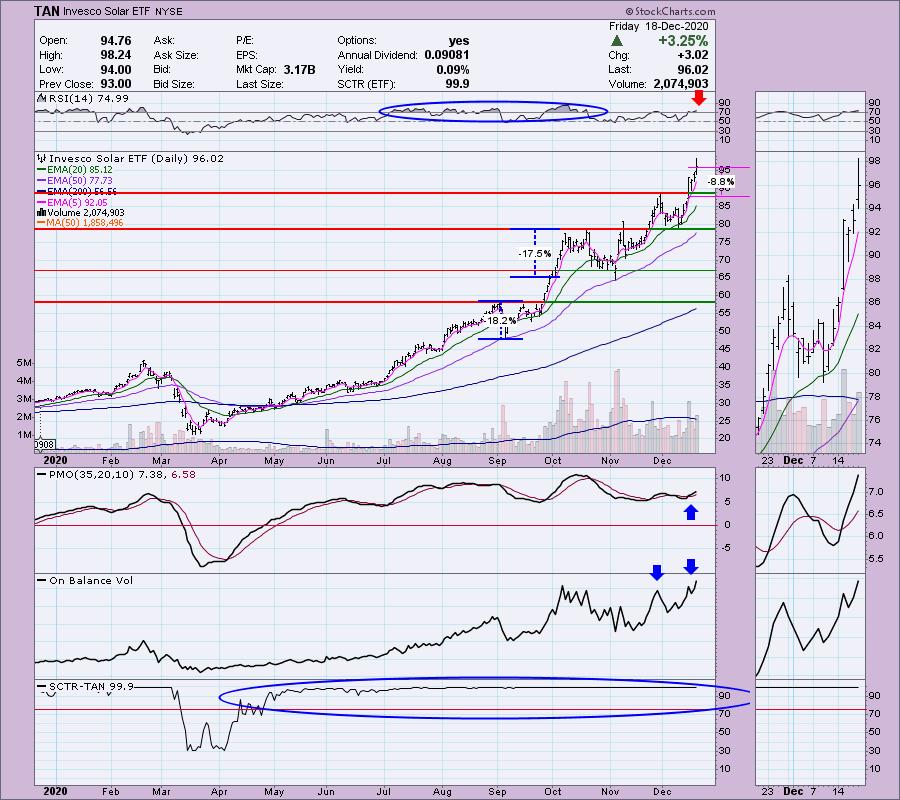

***Click here to register for this recurring free DecisionPoint Trading Room!***
Did you miss the 12/14 trading room? Here is a link to the recording (password: 7dJNVe6+). For best results, copy and paste the password to avoid typos.
Our Holiday Special is still running! Save 15% on all DecisionPoint.com subscriptions! Coupon Code: holiday2020

Rather than do a "Diamond of the Week", I thought I would review two of my favorite stocks within this space. Full disclosure, I do own SPWR.
TPI Composites, Inc. (TPIC)
EARNINGS: 2/25/2021 (AMC)
TPI Composites, Inc. is a holding company that engages in the manufacture of composite wind blades for the wind energy market. It operates through the following segments: United States (US); Asia; Mexico; and Europe, the Middle East, and Africa (EMEA). The US segment includes the production of wind blades in Newton, Iowa plant; and manufacturing of precision molding and assembly systems used for the manufacture of wind blades in Warren, Rhode Island facility, and composite solutions for the transportation industry. The Asia segment produces wind blades in Taicang Port, Dafeng, and Yangzhou, China facilities. The Mexico segment focuses its operation of wind blades in Juárez and Matamoros, Mexico. The EMEAI segment offers wind blades from two facilities in Izmir, Turkey; and also performs wind blade inspection and repair services. The company was founded by Everett Pearson and Neil Tillotson in 1968 and is headquartered in Scottsdale, AZ.
I presented this one yesterday in the DecisionPoint Diamonds Report. Below is what the chart looked like on Thursday with my comments:
12/16: "This one comes from my favorite industry group, Renewable Energy. If you aren't in solar, I recommend you consider it. It can be bouncy, but overall the returns have been excellent! Right now, TPIC has an ascending triangle which is bullish with an expectation of an upside breakout. The RSI is positive and not overbought. The PMO is headed back up for a BUY signal."
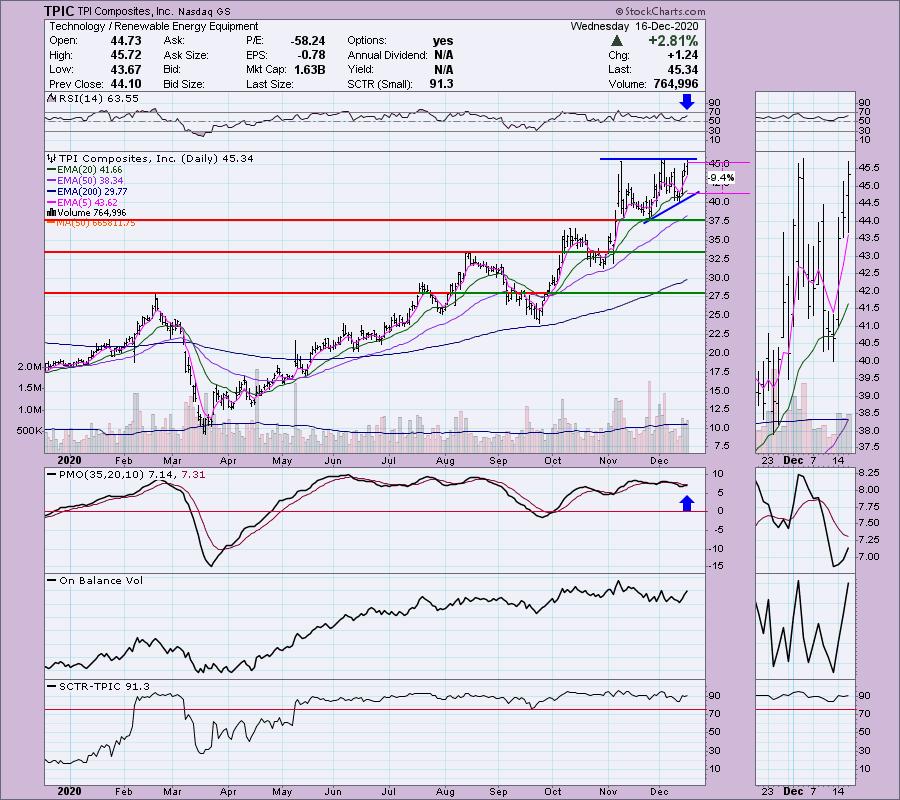
Here is the current chart. As you can see, today that triangle resolved as expected to the upside. I wasn't expecting a rally this powerful, but the set up was nice yesterday. This has moved TPIC into overbought territory as far as the RSI. The PMO is overbought, but it is rising strongly. As noted with TAN in the opening, these stocks can stay overbought for some time, but they generally will include a pullback or pause before the next leg up. I would watch for a pullback toward the breakout point to make an entry.
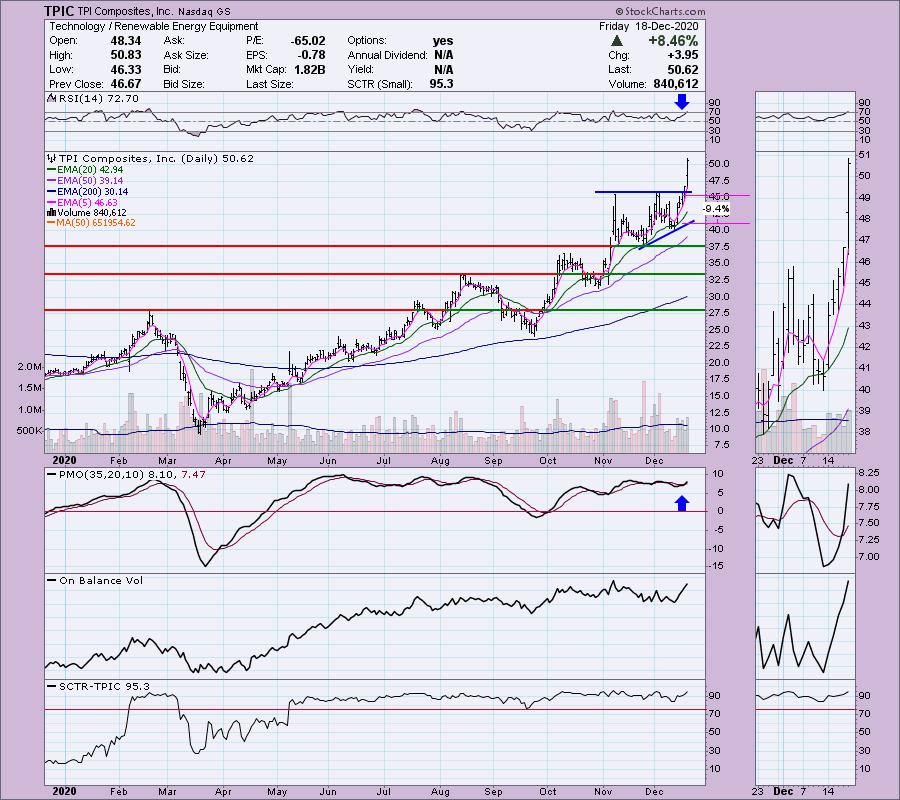
SunPower Corp. (SPWR)
EARNINGS: 2/10/2021 (AMC)
SunPower Corp. engages in the design, manufacture and deliver of solar panels and systems. It operates through the SunPower Energy Services and SunPower Technologies segments: The SunPower Energy Services Segment deals with the sales of solar energy solutions in the North America region including direct sales of turn-key engineering, procurement and construction. The SunPower Technologies Segment involves technology development, worldwide solar panel manufacturing operations, equipment supply to resellers, commercial and residential end-customers outside of North America. The company was founded by Thomas L. Dinwoodie, Robert Lorenzini and Richard M. Swanson in April 1985 and is headquartered in San Jose, CA.
I covered SunPower Corp back on September 30th for Diamonds subscribers. Below is my commentary:
9/30: "This area of the market has been enjoying a huge rally. It has broken out of a bullish falling wedge and has now popped above the September top. It was up much higher than this intraday, so this mid-day pullback could work to our advantage. The PMO is rising nicely and isn't that overbought. The RSI has remained strong along with the SCTR. Volume has been pouring in and price is following that volume based on the OBV breaking to a new high with price."
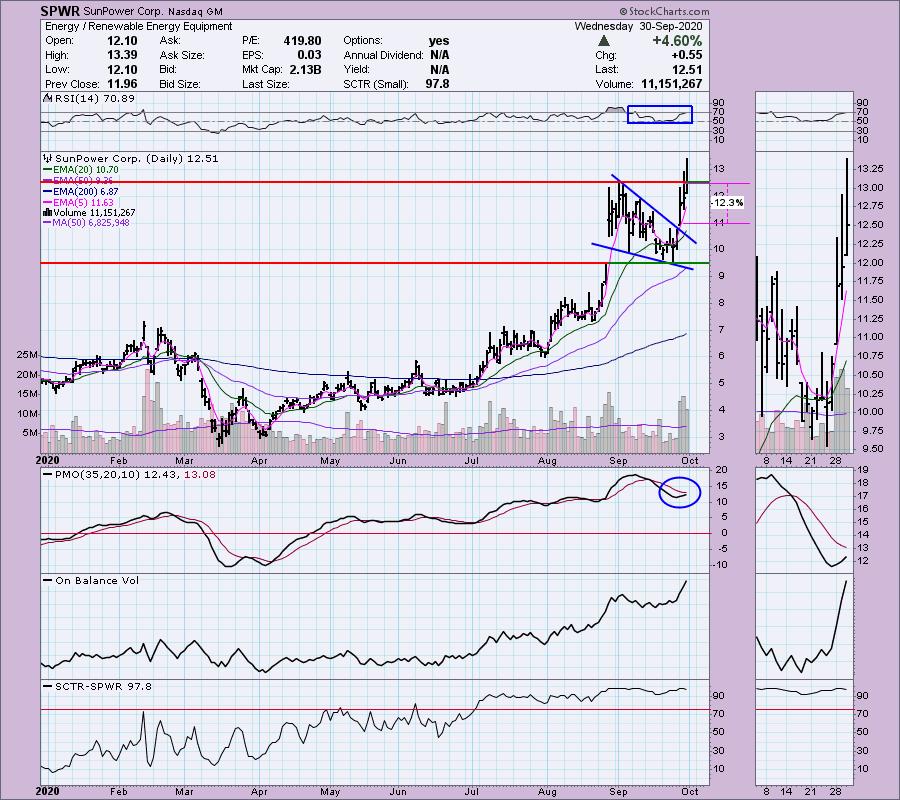
Here is the same chart today. SPWR has enjoyed a 103% gain since I presented it. The PMO has just triggered a BUY signal. The RSI is getting overbought, but the PMO is not overbought, which tells me there is more upside on this stock. Notice that our stop level was never hit.
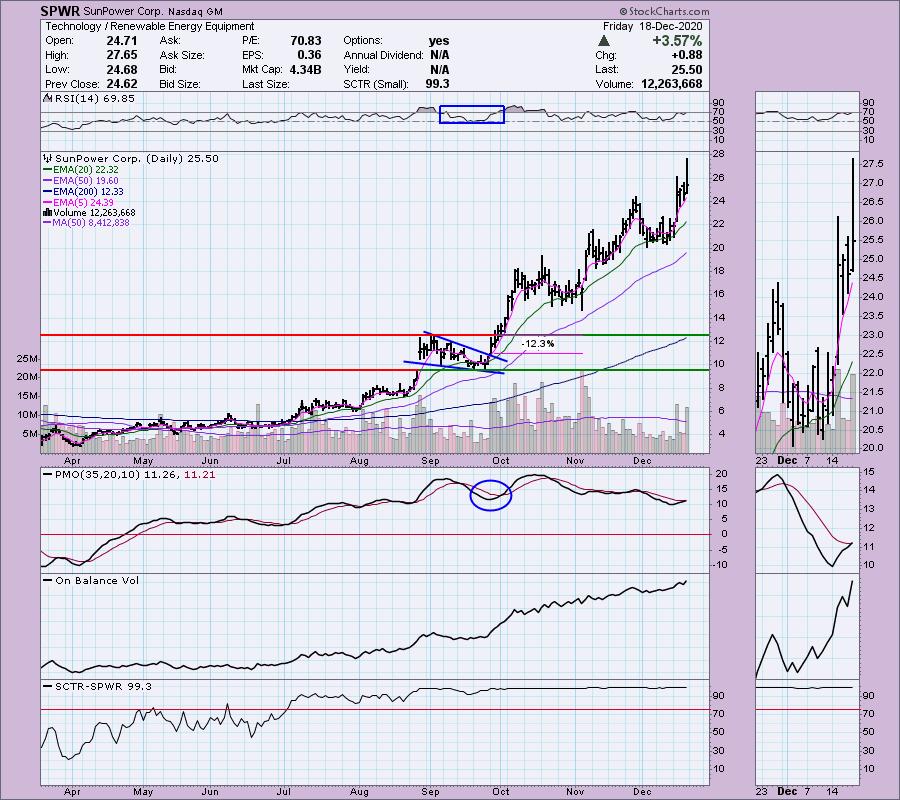
Conclusion: If this type of analysis is appealing to you, join me in the free trading room on Mondays. Registration links are above. I've been talking about solar in those free trading rooms as well. Overall, I do believe that the renewable energy group is teflon. I believe that while it will take some punches when the market does, overall I expect the long-term rising trend to remain intact.
Have a great holiday and don't forget, all DecisionPoint.com subscriptions are 15% off when you use the coupon code: holiday2020. Treat yourself to a prosperous new year with top-notch technical analysis and stock picks!
Happy Charting! - Erin
eheim@decisionpoint.com
Technical Analysis is a windsock, not a crystal ball.
Helpful DecisionPoint Links:
DecisionPoint Alert Chart List
DecisionPoint Golden Cross/Silver Cross Index Chart List
DecisionPoint Sector Chart List
DecisionPoint Chart Gallery
Trend Models
Price Momentum Oscillator (PMO)
On Balance Volume
Swenlin Trading Oscillators (STO-B and STO-V)
ITBM and ITVM
SCTR Ranking
|
| READ ONLINE → |
|
|
|
| The MEM Edge |
| These Stocks are Poised for Explosive Moves Higher! |
| by Mary Ellen McGonagle |
The broader markets are in an upward trending phase with positive news of a COVID vaccine helping investors to look past a steady uptick in virus cases. To be sure, the markets are forward-looking, and the likely prospect of a partisan split Congress, coupled with steady reports that point to an economic recovery into next year and beyond, has also helped push the markets to new highs.
While many stocks will rise along with the markets, my MEM Edge Report is all about uncovering top performers that go on to trade much higher and much faster than the broader Indices. Every week, we have several stocks from our curated Suggested Holdings List that are in the top 10 performers of their given index.
When you're on the hunt for big, winning stocks poised to outperform, there are certain criteria that, when in place, are proven to boost the odds of that stock's swift ascent. Below are several names that are currently exhibiting signs that they're ready to take off.
DAILY CHART OF TOPBUILD CORP. (BLD)
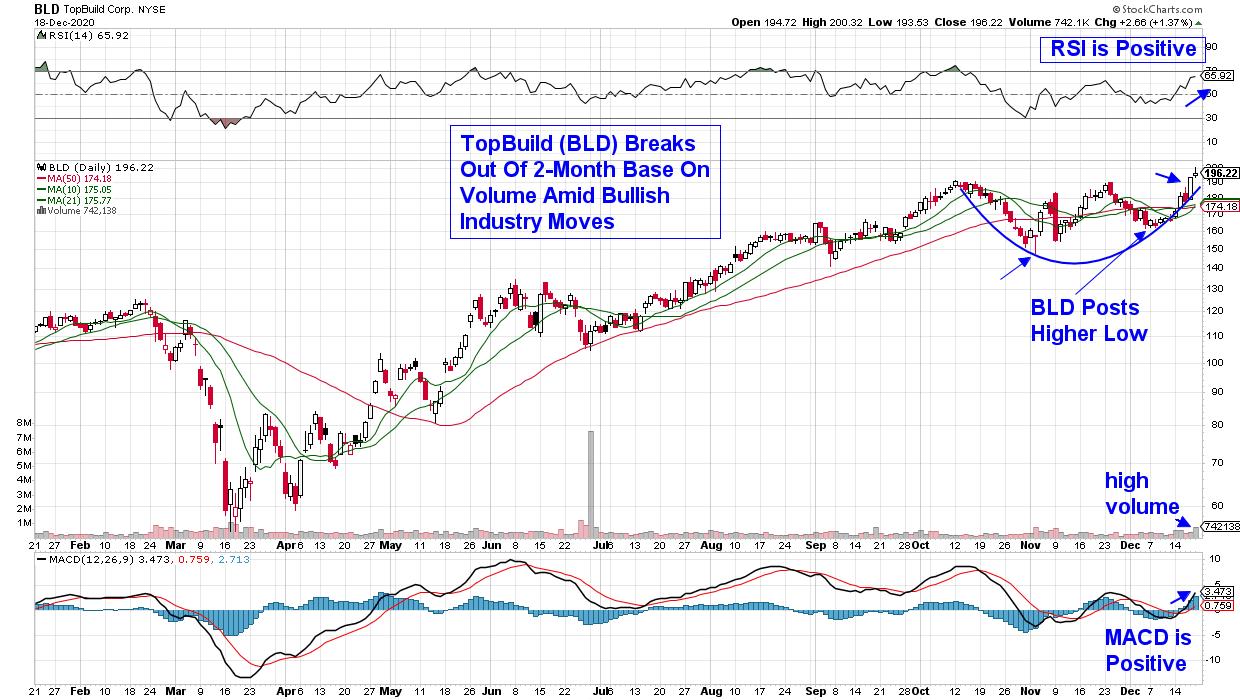
First up is a Smaller Cap name that's in the process of regaining its momentum from earlier in the year, when it posted strong gains. Topbuild Corp. (BLD) just broke out of a base on heavy volume today on the heels of a price target increase from a major Wall Street firm.
This installer of insulation and other building products also received a boost from Thursday's strong Housing Starts numbers for November, as well as a surge in permits for future new homes to be built. While the stock is extended following its strong move this week, with a positive RSI and MACD along with its base breakout, I'd be a buyer on any pullback.
DAILY CHART OF LULULEMON ATHLETICA INC. (LULU)
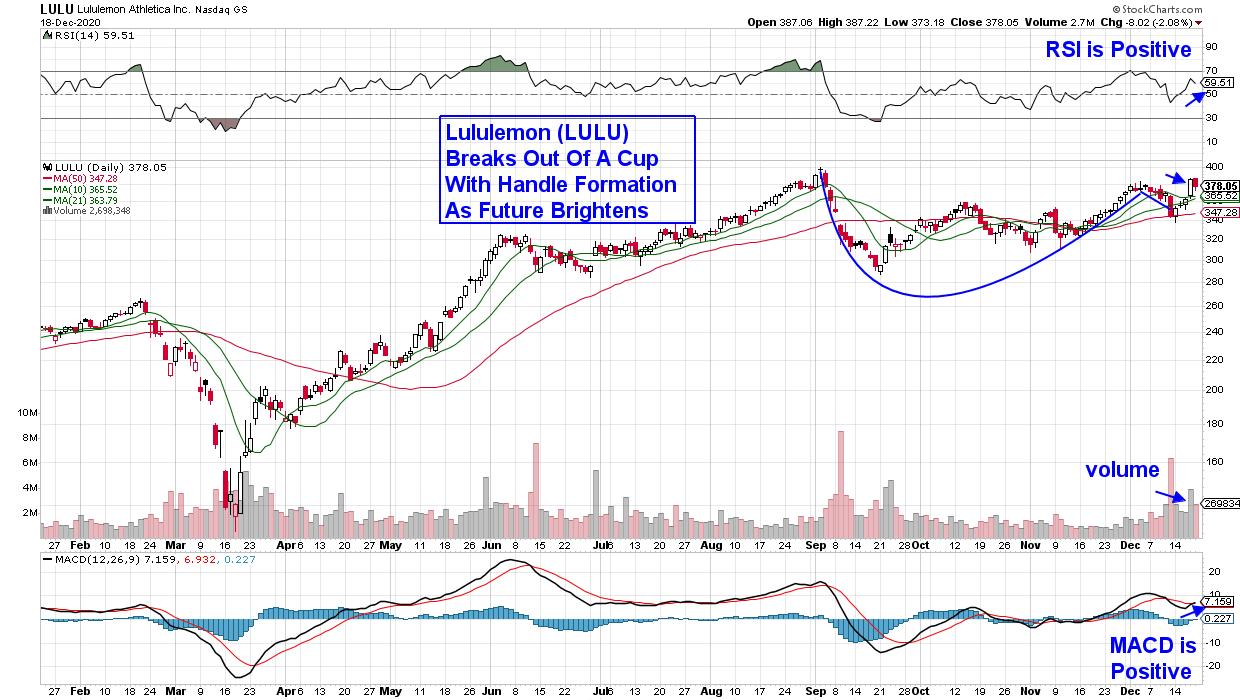 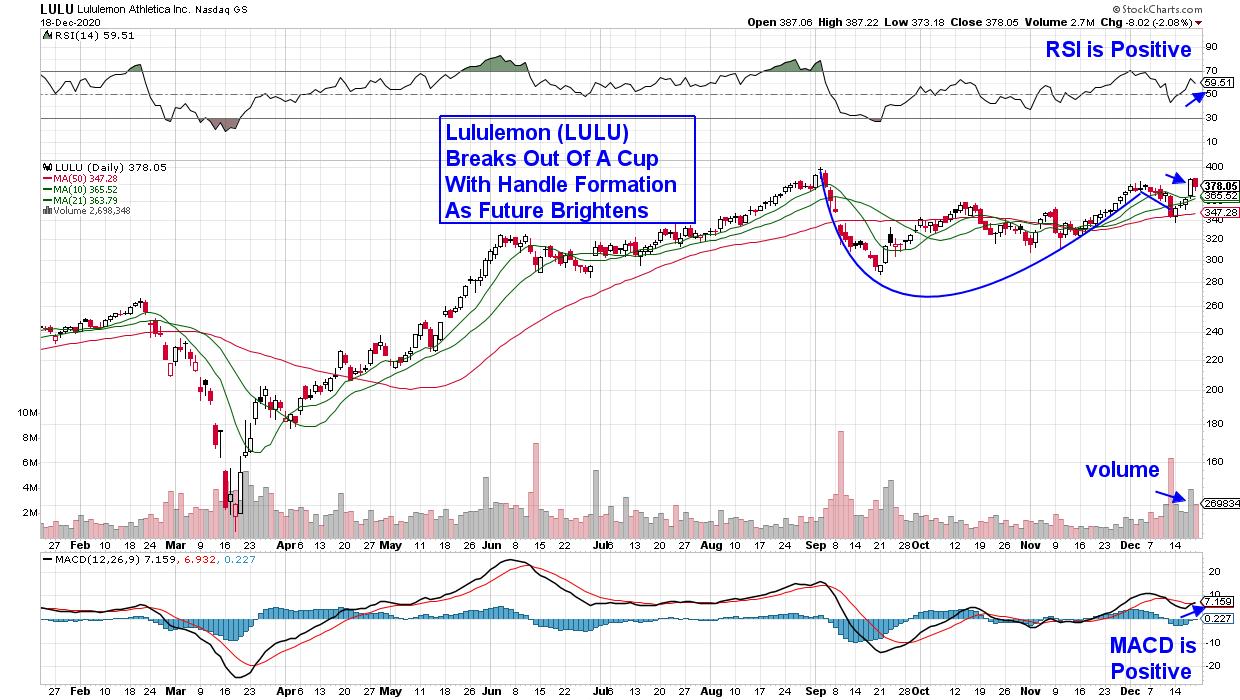
Next up is another winner from the early stages of the pandemic that's on its way to regaining its March-September luster. This producer of athleisure-wear saw sales surge in the face of mandated lockdowns; however, Lululemon (LULU) dropped sharply following 2nd quarter results that were not strong enough to support its lofty valuation.
The company reported strong 3rd quarter results last week, which showed it's executing its e-commerce strategy successfully as direct to consumer sales soared 94%. Bullish comments from CEO Calvin McDonald this week boosted shares out of a cup-with-handle formation as analysts raise their estimates for this year and next.
DAILY CHART OF VEEVA SYSTEMS (VEEV)
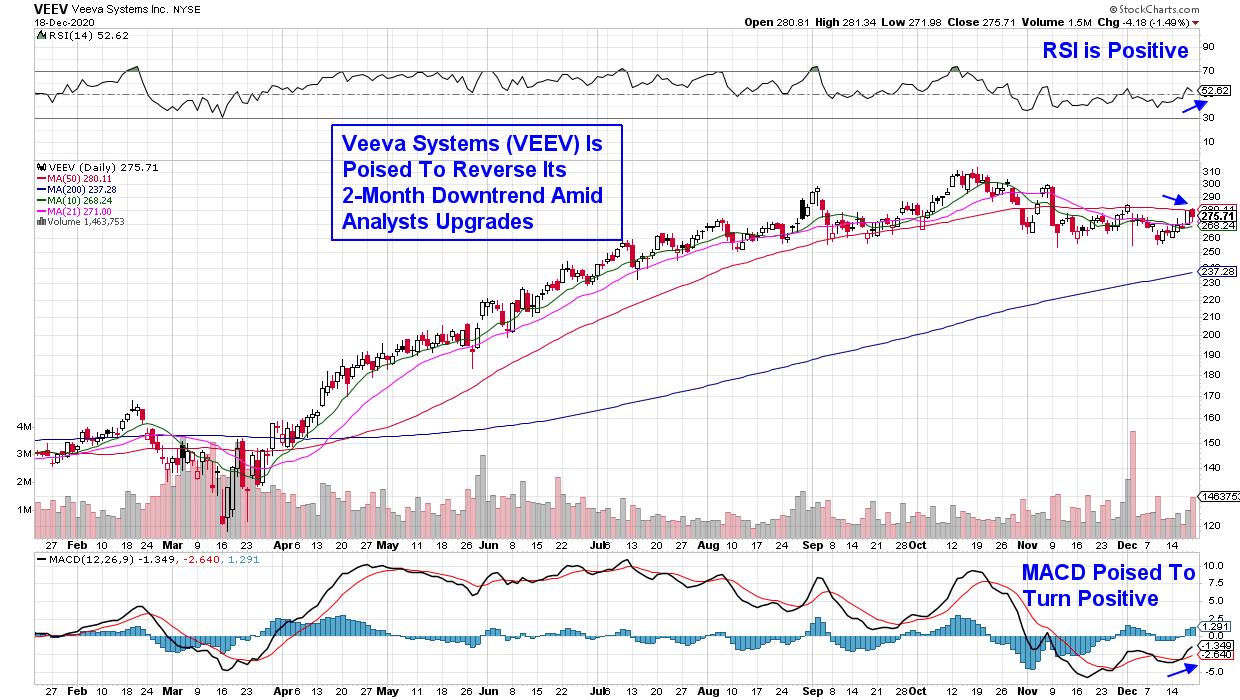
This last stock above is not quite ready for lift-off, but keep it on your watch list as estimates are continuing to be revised higher for both 2021 and 2022. As you may know, strong earnings is the primary driver of a stock's accelerated move higher and, Veeva Systems (VEEV) is marked for record earnings growth going forward.
In early December, Veeva Systems (VEEV) reported 3rd quarter results that beat expectations while guiding higher into next year, as the software provider to the Life Sciences industry is seeing strong demand. The stock is poised to reverse its 2-month downtrend as it recovers from the selloff in Software stocks that began in mid-October. A break back above its 50-day moving average on volume would be very bullish.
As noted above, stocks poised to outperform the markets need to have bullish chart patterns in addition to strong growth prospects. An additional aspect is that the stock is in a strong industry group that's outperforming the markets, such as VEEV, which is in the Software group that has many leading stocks that are currently on our Suggested Holdings List.
In addition, positive news regarding the company's industry also boosts its prospects, such as BLD, which supplies to a strong housing market that's continuing to see demand outstrip supply.
There are other criteria for leading stocks as well, and if you'd like to be educated on them while also being alerted to outstanding stocks that are on their way to outperform the markets, take a trial of my top-performing newsletter that's delivered bi-weekly. We have a special 4-week rate for just $7.00!
In addition to entry and exit points for selected stocks, you'll receive market and sector insights not seen elsewhere. We had VEEV and LULU on our list earlier in the year and they were big winners before we removed them upon their breaks below key support. You can check out some of our recent picks here.
Happy Holidays Everyone!
Mary Ellen McGonagle, MEM Investment Research
|
| READ ONLINE → |
|
|
|
|
|
| MORE ARTICLES → |
|
 Chart 1
Chart 1 Chart 2
Chart 2 Chart 3
Chart 3 Chart 4
Chart 4 Chart 5
Chart 5 Chart 6
Chart 6 Chart 7
Chart 7 Chart 8
Chart 8 Chart 9
Chart 9 Chart 10
Chart 10 Chart 11
Chart 11







































